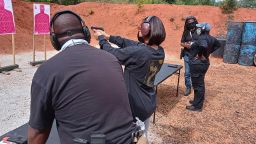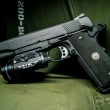Month: September 2022

Several times a week you can hear gunfire echoing from Brandi Joseph’s scenic Southern California property. A licensed firearms instructor and dealer, Joseph decided to open Fortune Firearms in December to serve a growing and rapidly changing clientele.
“There is a huge uptick in female owners,” Joseph said. “Women are getting trained; women are carrying… liberal and conservative.”
Proof of that change pulled up Joseph’s long, dusty driveway in the San Jacinto Valley just before 10 a.m. for a Saturday social, of sorts. A group of seven African American women stepped out of their cars seemingly eager to start their first firearms training session.
“Our society and climate is changing… it’s just better to be prepared for your own safety and protection. That’s how we feel,” Laronya Day, who organized the outing, said.
Now in their early 50s, the women have been friends since they were kids in Los Angeles, about two and a half hours from Joseph’s business. And most of them acknowledge they lean left politically.
“Do you have some friends who would be totally turned off by this?” we asked Charlean Ward. “Absolutely,” she responded. “That’s their choice; I’m exercising my choice.”
Jamie Beverly looked less certain, if not uneasy. “Seeing all the guns on the table, I was like ‘ugh,’” Beverly said. “Would you ever want to carry?” we asked her. “I don’t think so,” she whispered.
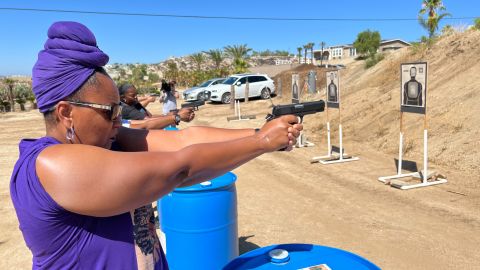
Over the course of nearly two hours, Joseph led a detailed instruction, teaching the women about everything from the types of handguns best suited for self-defense to how to load and disarm a firearm. Only after the women had repeatedly loaded the cartridge, inserted the magazine, chambered the gun, and then doing it all in reverse, did Joseph determine they were ready to fire at their paper targets.
Echoes of gunfire rippled through the rural valley as the women pulled their triggers.
‘I definitely am more closeted being a gun owner’
About an hour east of Los Angeles, Yessica Mendez and her wife Crisia Regalado met with their instructor Tom Nguyen at Burro Canyon Shooting Park. But Regalado, 25, admits she at first wanted nothing to do with guns.
“Just the sounds… the vibrations of each impact… made me very jittery and shaky and I had to excuse myself out of the range,” Regalado recalled. “I don’t know, it just triggered something inside of me and it made me scared.”
Mendez, 30, was equally disinterested in guns at first. But in recent years she’s felt a growing need for self-protection.
“I’m a Mexican woman in a same-sex relationship; I need to feel safe. I need to feel protected,” Mendez said. “And right now the laws and the things that are going on don’t make me feel safe and don’t make me feel protected.”
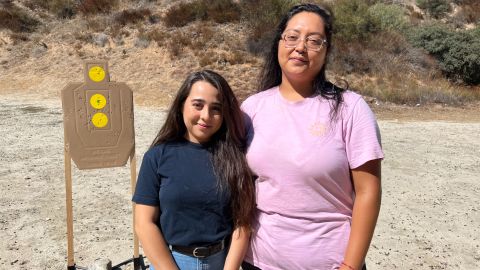
She convinced her wife to join her for a training session with Nguyen, who began LA Progressive Shooters in 2020.
“I never intended to become an instructor, but the need from the community was there,” Nguyen said. “And there’s also folks from my own liberal community who see me as, ‘oh you like guns you must be a gun nut.’ But that’s not really it at all.”
Nguyen says his clients are mostly liberal and from all backgrounds, genders and sexual orientations. He prides himself on creating an inclusive student base.
“The more I educate those who are formally anti-gun the more they actually realize that there’s more nuance to it,” he said.
Both Mendez and Regalado now have their own guns and are working toward getting their concealed carry permits. But they avoid talking about their guns with friends, who they say are firmly anti-gun.
“They’re really not open to understanding,” Mendez said. Adding that she feels more comfortable discussing her same-sex relationship with friends than her guns. “I definitely am more closeted being a gun owner, for fear of retaliation.”
Finding common ground at the range
Both Mendez and Regalado at first worried about the type of people they encounter at the gun range, many of whom, they say, advertise their conservative politics in what they’re wearing or listening to.
“It’s mostly all men, mostly all white men, older men like 70s, 80s,” Mendez said. “Seeing people looking at us, and kind of just staring… It always makes us more uncomfortable. Because we’re like, ‘oh my God are they going to come and tell us, like, get out of here… you don’t belong here.’”
Instead, they’ve gotten a different reaction.
“They’re like, ‘Hey, you’re doing well, but can I show you something that might help you more?,” Mendez said.
Mendez says not only has it changed her impression of those individuals, but she also believes it’s given some a different perception of people like her.
“When I (came) back the next day, (one of the men) was like, ‘Hey! I saw your wife out there – she looks nice. Tell her I said ‘hi’.”
Still, as a Mexican-American immigrant in a same-sex marriage Mendez feels pulled in different directions politically.
“But at the end of the day I have to choose. Am I going to choose guns? Or am I going to choose my relationship? And I will always choose my relationship, but it’s just like a shame that we can’t come together and feel safe,” she said.
De-stigmatizing lawful gun ownership
Gun sales in one of the country’s few black-owned gun shops, Redstone Firearms in Burbank, California, soared post-pandemic and have remained steady, according to co-owner Jonathan Solomon.
“It’s not just one demographic. It’s not just one ethnic group. There’s just not one level of income… it’s a wide variety of folks that come in here now,” he said.
While white men have the highest rates of gun ownership in the US, one survey shows that in the first half of 2021 roughly 90% of retailers saw a surge in gun sales to African Americans. The same survey found that about 80% of retailers reported an increase in firearm purchases by Hispanic and Asian Americans.
Solomon, a former police officer, opened the shop about nine years ago with his wife Geneva. He says his new, diverse customers are primarily buying their first gun for a shared reason: self-protection. But he warns them to pay close attention to the rapidly changing regulations on firearms.
“It’s a consistent education when it comes to gun laws, especially in California,” Solomon said.
California is consistently rated among the states with the toughest gun laws. There are strict policies aimed at dissuading hasty gun purchases, including a 10-day cooling off period from when you buy a gun to when you can take it out of the store. And getting a concealed carry permit in places like Los Angeles can take more than a year and include background checks and interviews.
“It’s really convenient to think that if we just ban an object, if we just ban guns, then all of our problems would be solved – all of society’s problems would be solved – but that’s not true,” said firearms instructor Nguyen.
Nguyen said more and more residents are willing to put in the time and go through the hurdles to legally buy and carry a gun. And he says most of his clients support tough gun regulation so long as there’s clarity, consistency and still a path toward legal gun ownership. He only hopes they incorporate education and training into that process.
“I want to de-stigmatize lawful and responsible gun ownership,” Nguyen said.
‘I just feel liberated’
After completing their two-hour class at Fortune Firearms, most of the group of seven childhood friends were noticeably more comfortable in their new-found knowledge.
“I just feel liberated,” Ward said. “I feel like, let’s move to the next step: license to carry, get the concealed weapon.”
Data from Harvard found that more than half of new gun owners are likely to be women. Joseph says many of her clients are more liberal women who don’t advertise that they’re carrying.
“Most people have (in mind) the cookie-cutter firearm owner… right-wing…. But then there’s the other side that is quiet. They own guns. They’re buying them. They’re stockpiling ammo. It’s just not on their Facebook pages and it’s not their profile pictures,” she said.
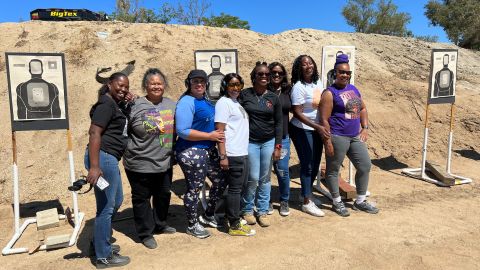
Day is now planning to move forward with carrying after Joseph’s class. “With all the things that you see on the news, things are happening more… in so many public areas, movie theaters, Walmarts, grocery stores…. It’s like there’s no limit now,” she said.
But gun ownership is not for everyone. Even after their course, within the close-knit group of friends there are differing opinions toward firearms.
“I think it’s great that more people are being educated and taking steps to protect themselves and protect their families,” Beverly said. “But for me personally, I’m still leery. I don’t think I would purchase (a gun).”
Taiwan under threat
I can’t speak for the other military branches, but the Marine Corps has a weapons-cleaning problem. When I say that, I mean we clean our weapons too much. Too much, and often incorrectly, to adhere to the strict standards of the Marine Corps. The problem is complicated and tied to both the lower enlisted and the higher-ups. If the Marine Corps wants its Marines to be the most lethal warfighters, it’s a problem it needs to solve. As it’s known in the Marine Corps, weapon maintenance needs to be revised.
THE PROBLEM WITH MODERN WEAPON MAINTENANCE
Keeping a rifle, machine gun, handgun, well, any gun, working relies on proper maintenance. Weapon maintenance is critical to the function of a weapon, especially in austere environments. We’ve fought for two decades in deserts, on snow-covered mountains, and in the worst places possible for modern weapons.
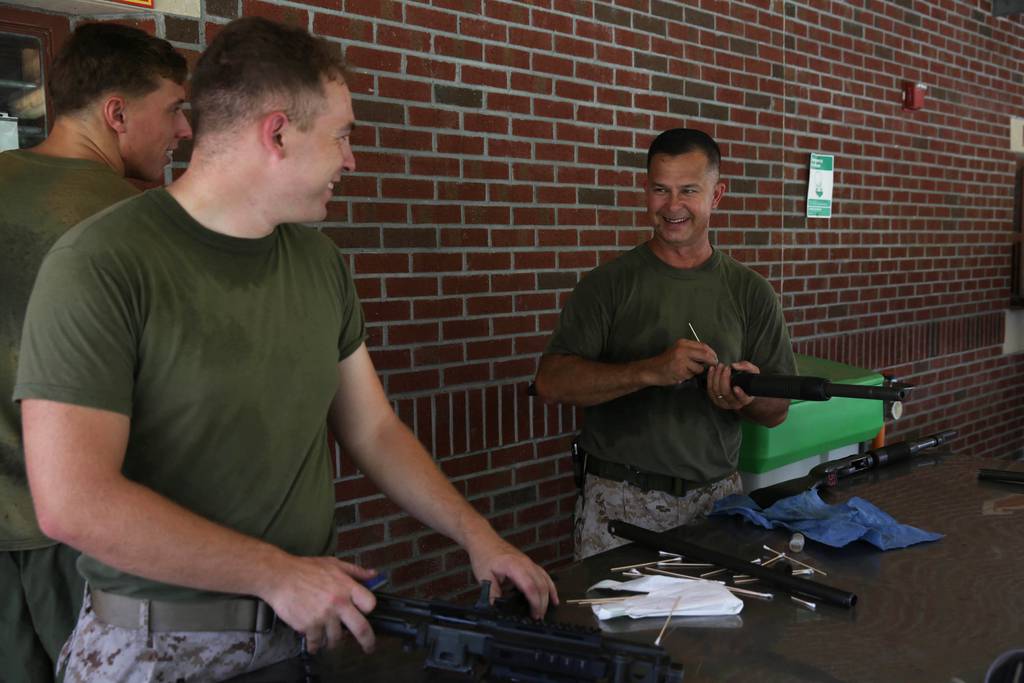
However, the extent the Marine Corps engages in weapon maintenance can be completely detrimental to the weapon. Marines find themselves using improper tools to reach a standard. For example, Marines will often use hard, stainless steel brushes to clean their weapon. When used enthusiastically, these brushes will eventually destroy the finish of the inside and outside of your weapon.
A good finish protects the weapon and helps prevent rust. Without a good finish, the weapon’s long-term reliability will be in question. My issue M9 was almost more silver than black since the finish had been rubbed off over time due to excessive cleaning.
Your average lower enlisted will likely lose or break his issued cleaning kit. This will, in turn, cause them to purchase one, which is often the cheapest one out there. These cheap cleaning kits will often have stainless steel bore brushes that can damage the rifling, making the weapon lose accuracy and consistency over time.
Marines should use bronze bore brushes mixed with bore cleaner in their weapon maintenance.
KEEPING IT SHINY

Even Marines who keep their issued cleaning kits will find them lacking and may supplement them with tools to speed up the chore. This includes Q-tips and baby wipes. I’m guilty of this, as was every infantry Marine I knew. However, Q-tips and baby wipes come with their own problems.
Q-tips break easily and can break off or deposit little bits of cotton in areas that can disable the weapon. They can get stuck in all manner of areas in rifles, but especially in machine guns. However, Q-tips do make weapon maintenance faster, and they can reach into the spots that fingers and AP brushes can’t.
Baby wipes provided the quickest means to remove dirt, dust, and carbon. The problem with baby wipes is their low concentration of alcohol and very high concentration of water which creates rust and oxidation. In time, this gathers in small cracks and pits and eventually causes rust. Rust creates more little places for water and alcohol to gather and rust. The use of baby wipes creates a vicious cycle that will wear the weapon down sooner, creating a need for more weapon maintenance.
Finally, Marines will often turn in their weapons completely dry causing them to rust in the armory. A light coat of CLP prevents rust but can also be the reason a Marine fails inspection as CLP is slightly brown, so the weapon appears dirty when an inspector uses their finger, glove, or white patch.
WHY IS WEAPON MAINTENANCE A PROBLEM?
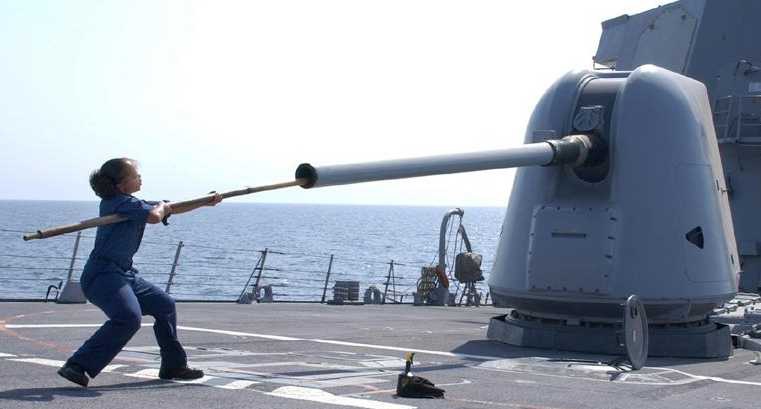
First, the Marine Corps culture demands perfection. If something can be cleaned, be it a humvee, a weapon, or a barracks room, it must be cleaned. This creates strict requirements for cleanliness. A weapon must be inspection-ready at all times. You never know when the commandant himself might bust into the armory and inspect the weapons.
To tap into that, lance corporals and PFCs can be lazy. Without the demand for perfection, things might be really slack. Give ’em an inch, and they’ll take ten clicks.
There is also a lack of education and clear objectives regarding weapon maintenance. You learn a little in boot camp, but it’s often sidelined in favor of drills, classes, and other training. Those cleaning methods are not retained in the feet, especially when the weapons go from rifles to machine guns, heavy machine guns, shotguns, pistols, missile launchers, and more.
HOW TO FIX IT?

The Marine Corps needs to revamp and re-evaluate its weapon maintenance program, tactics, and techniques. It needs to provide modern equipment and do so in bulk. Cleaning kits are cheap, guns are not, and neither is losing a firefight due to a broken weapon.
The Marine Corps should consult with the firearms industry on the most effective means to maintain weapons. They should also ensure that the troops and command are educated on what’s important in weapon maintenance and how to achieve proper weapon maintenance. No one ever told me not to use baby wipes, steel bore brushes, or Q-tips. I learned it from higher-ups.
Ultimately, the Marine Corps needs to accept that parade-ready weapons should be reserved for parades. Additionally, Marines need to accept responsibility for the tools of their trade and treat them as such. It’s a problem that starts at both the bottom and top of the branch and should be fixed before we worry about adopting new weapons.
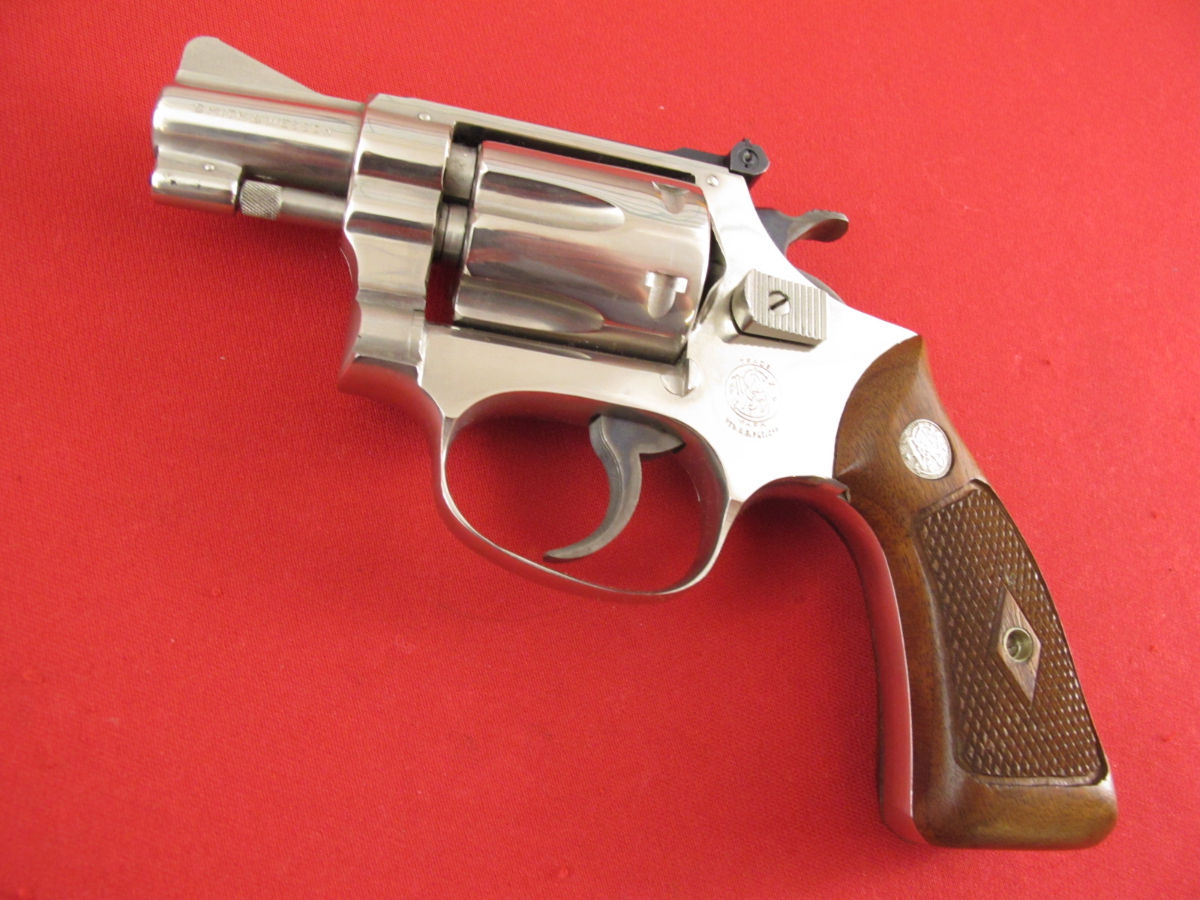
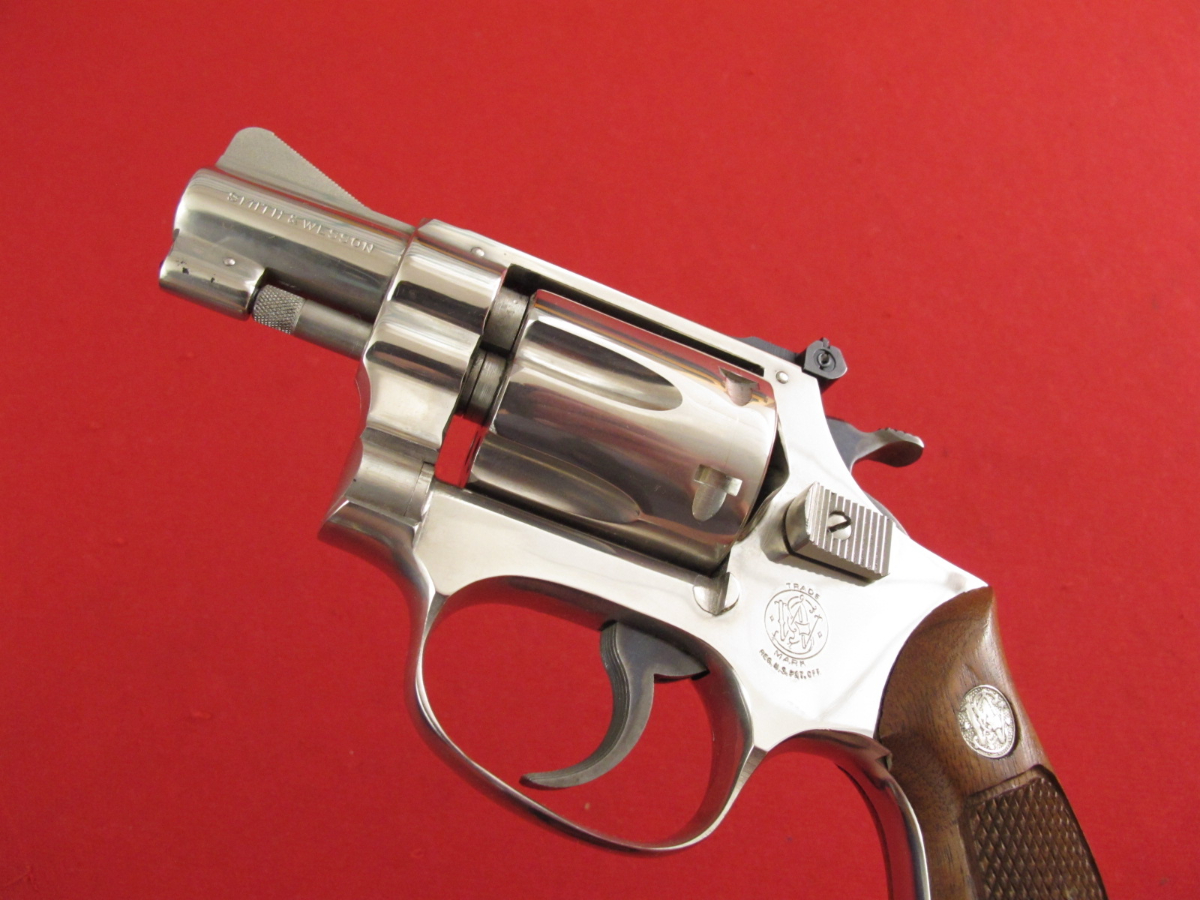
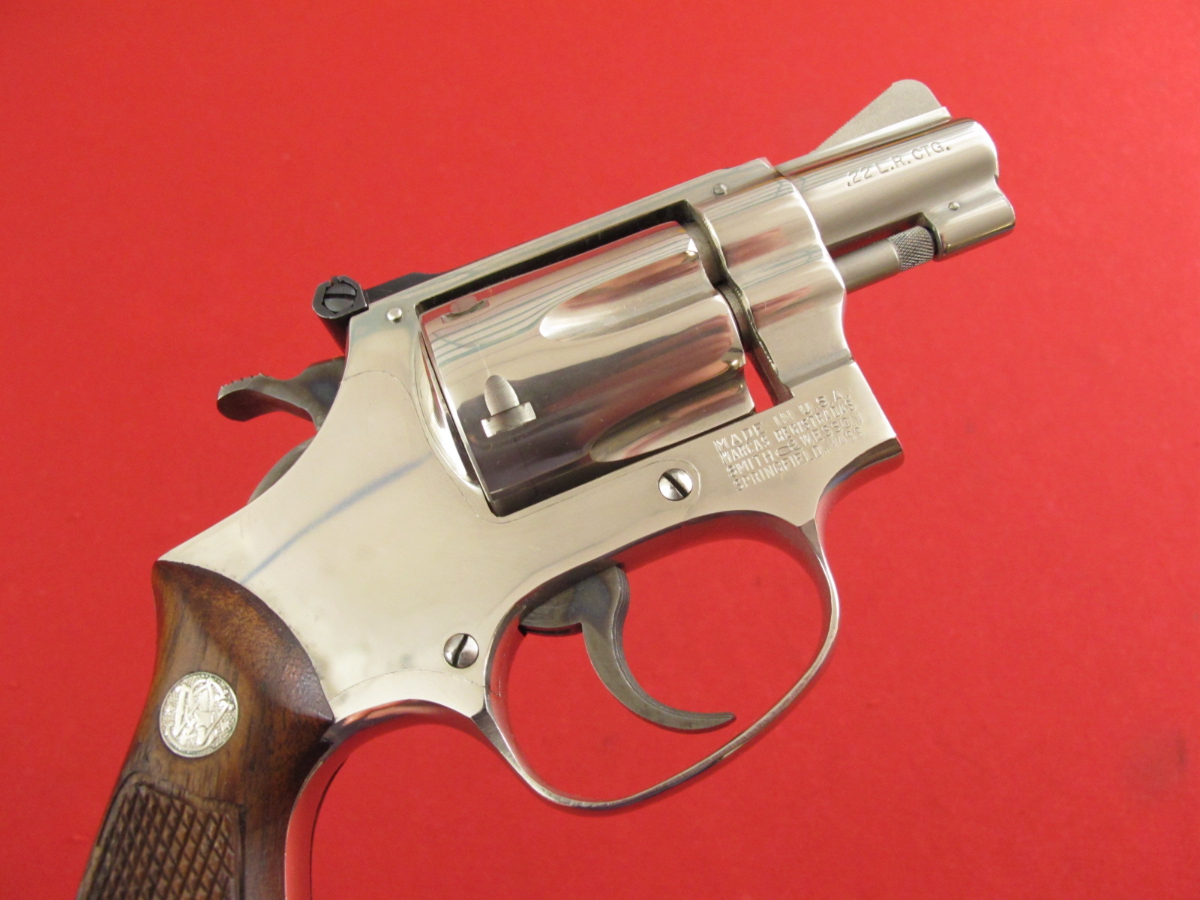
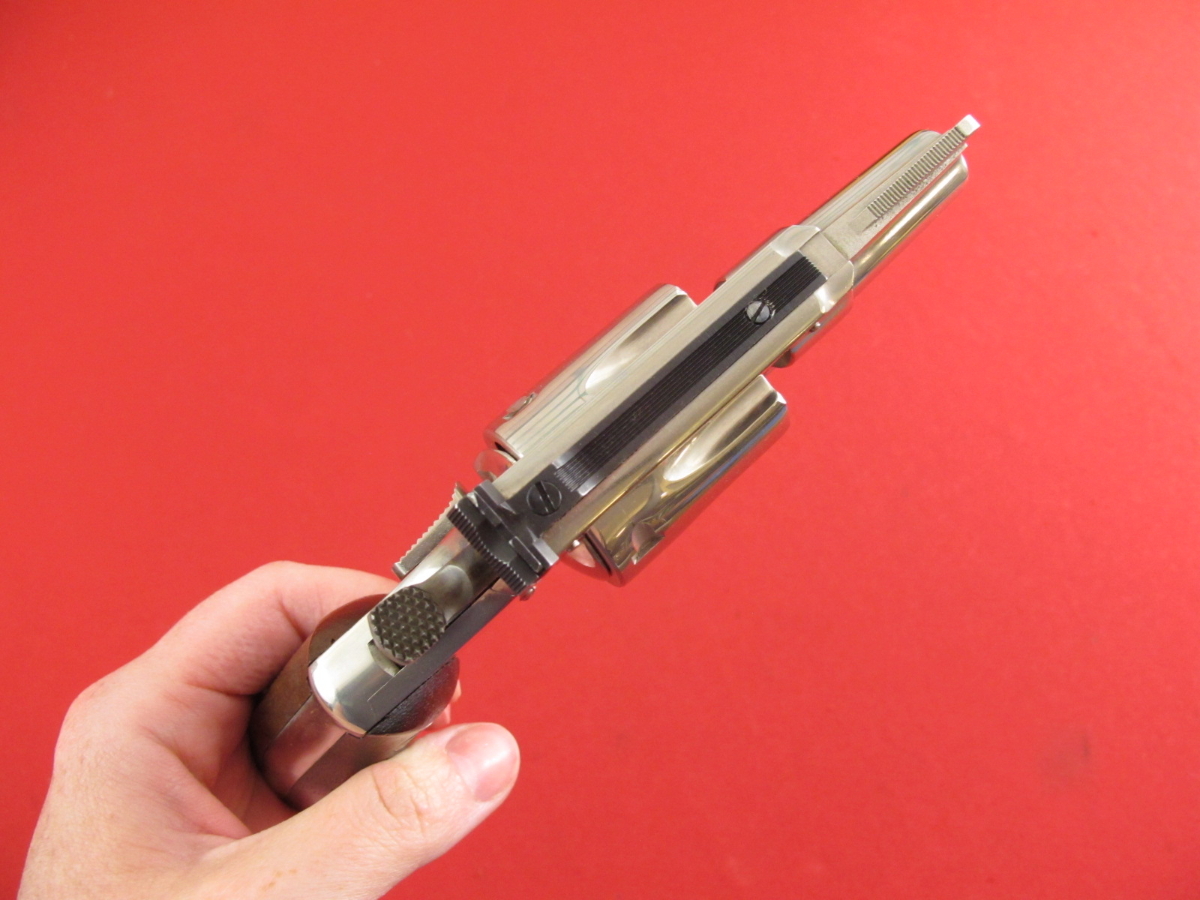
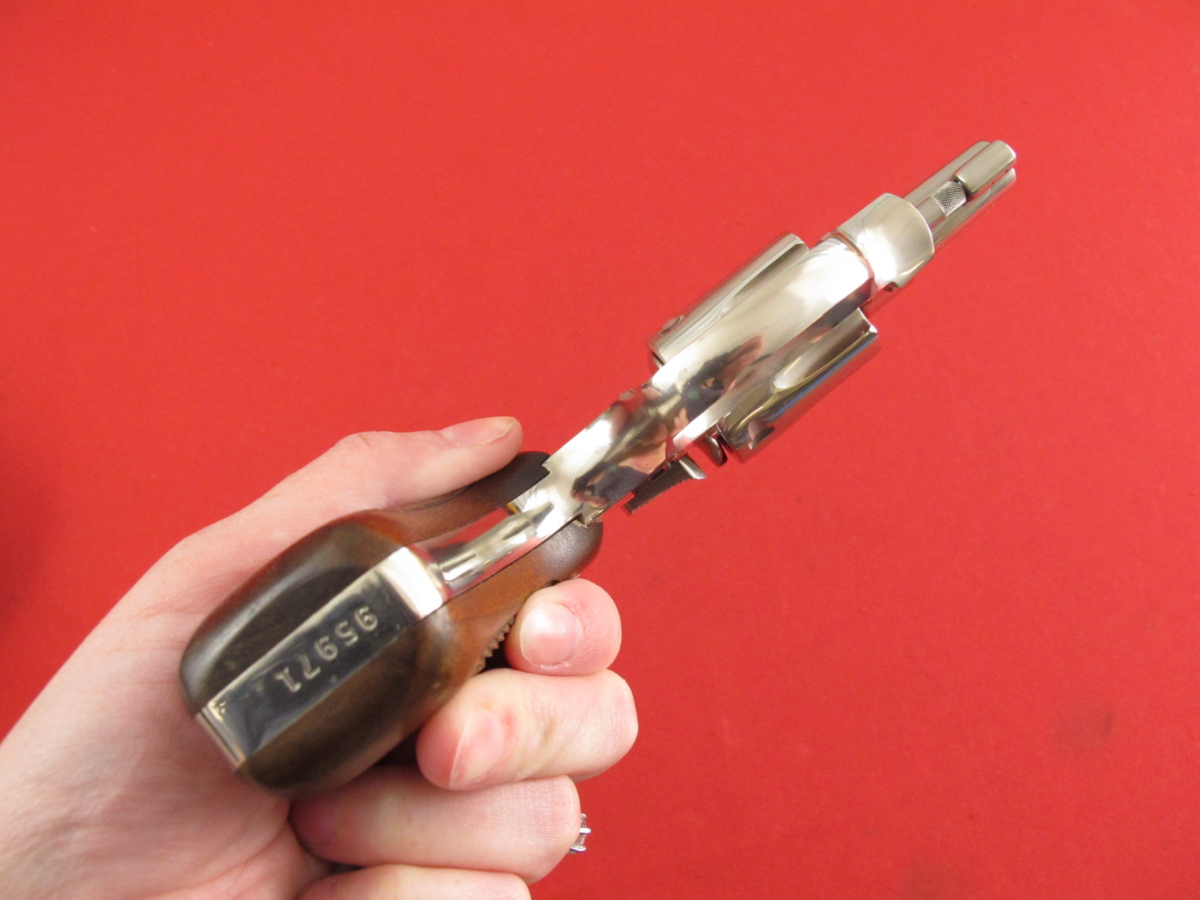
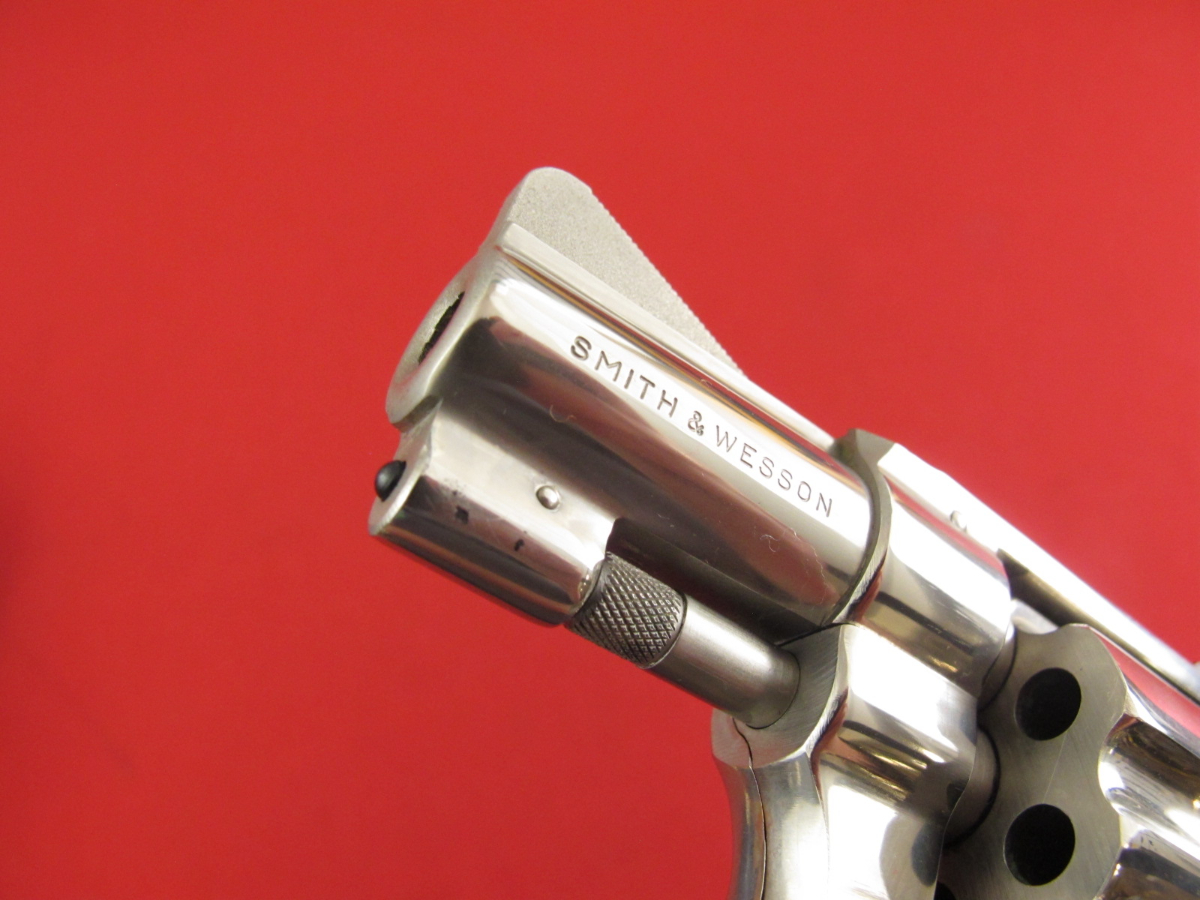
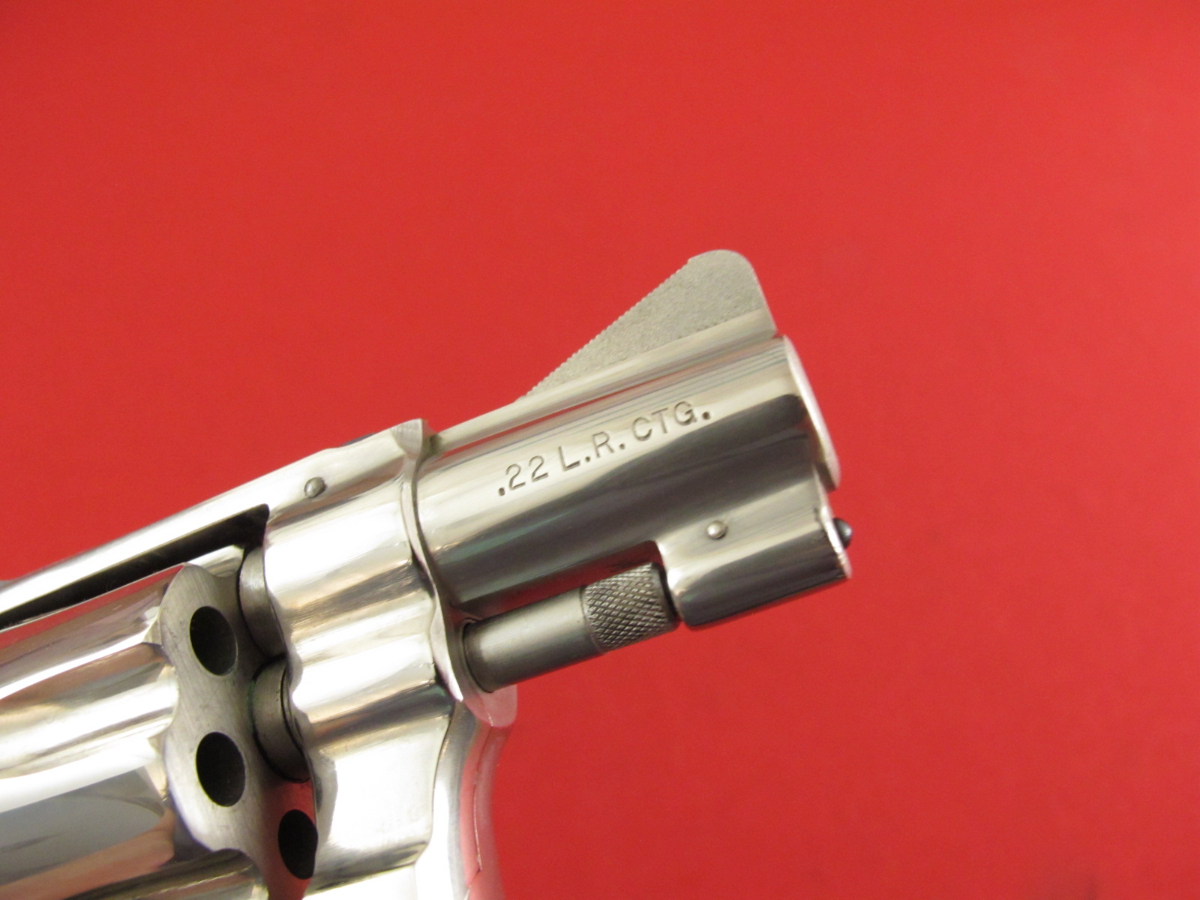
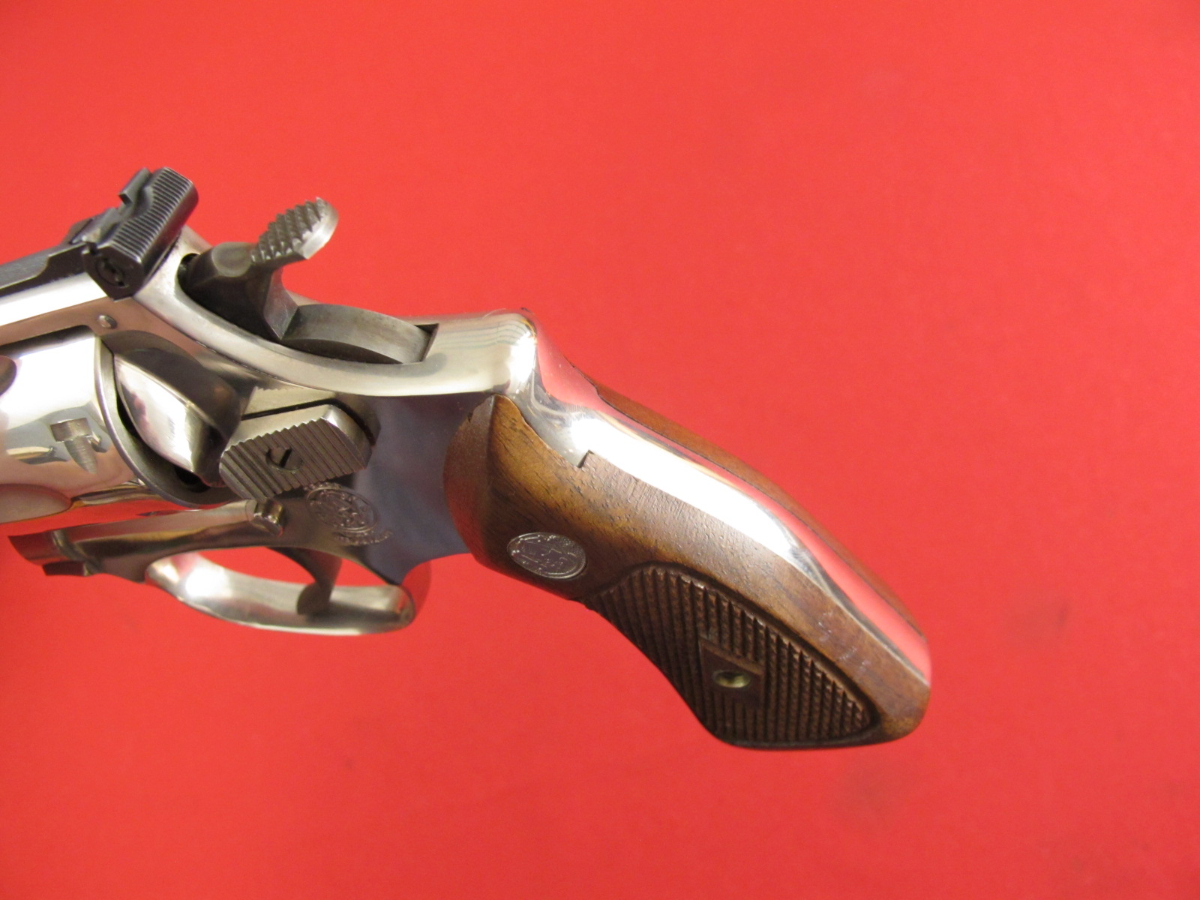
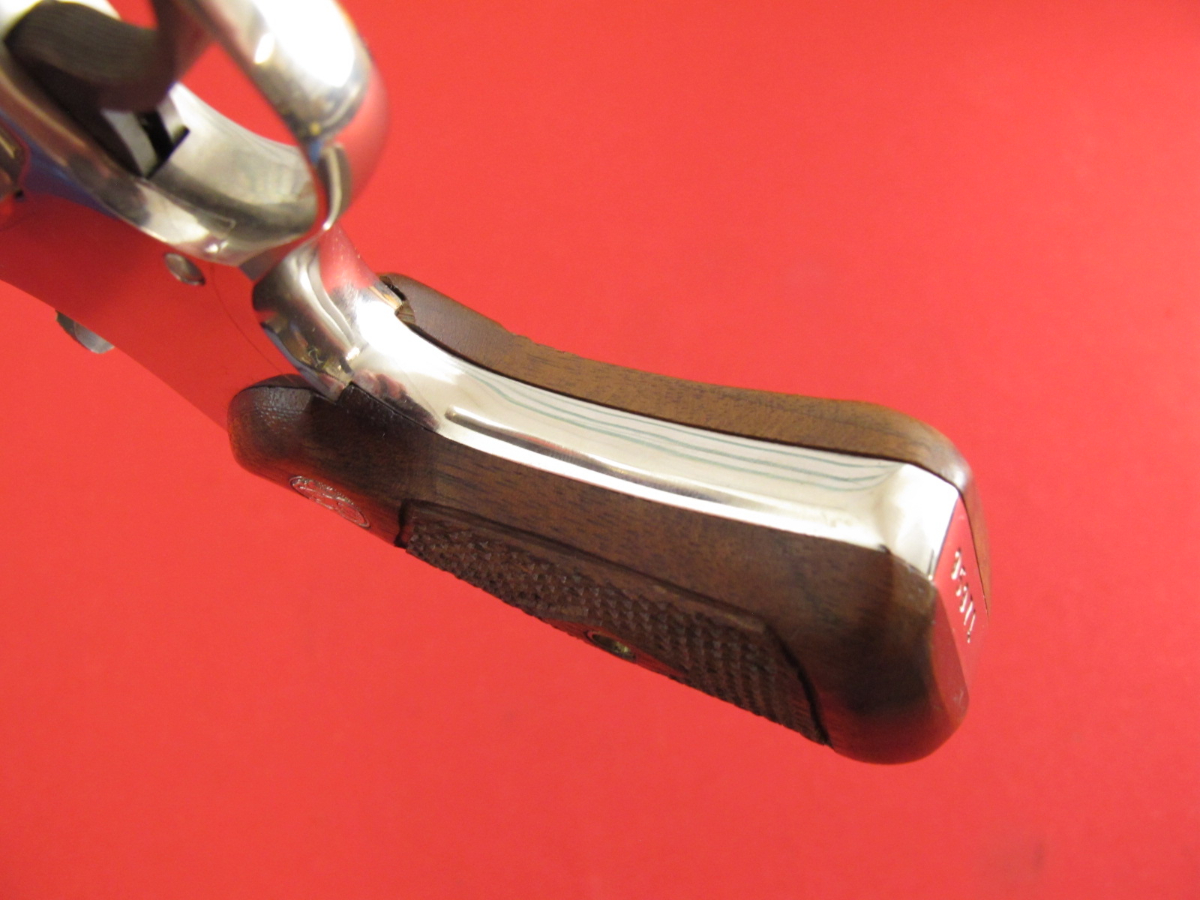
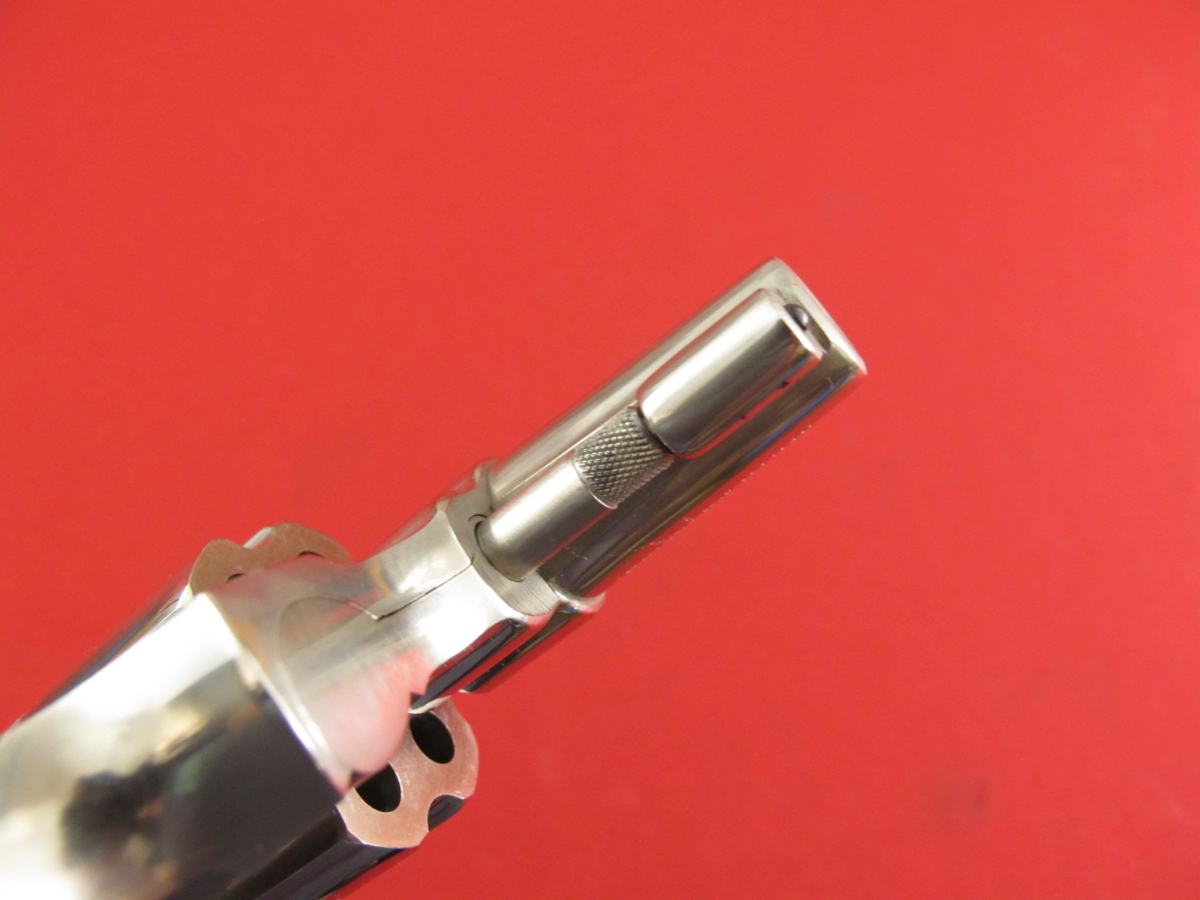
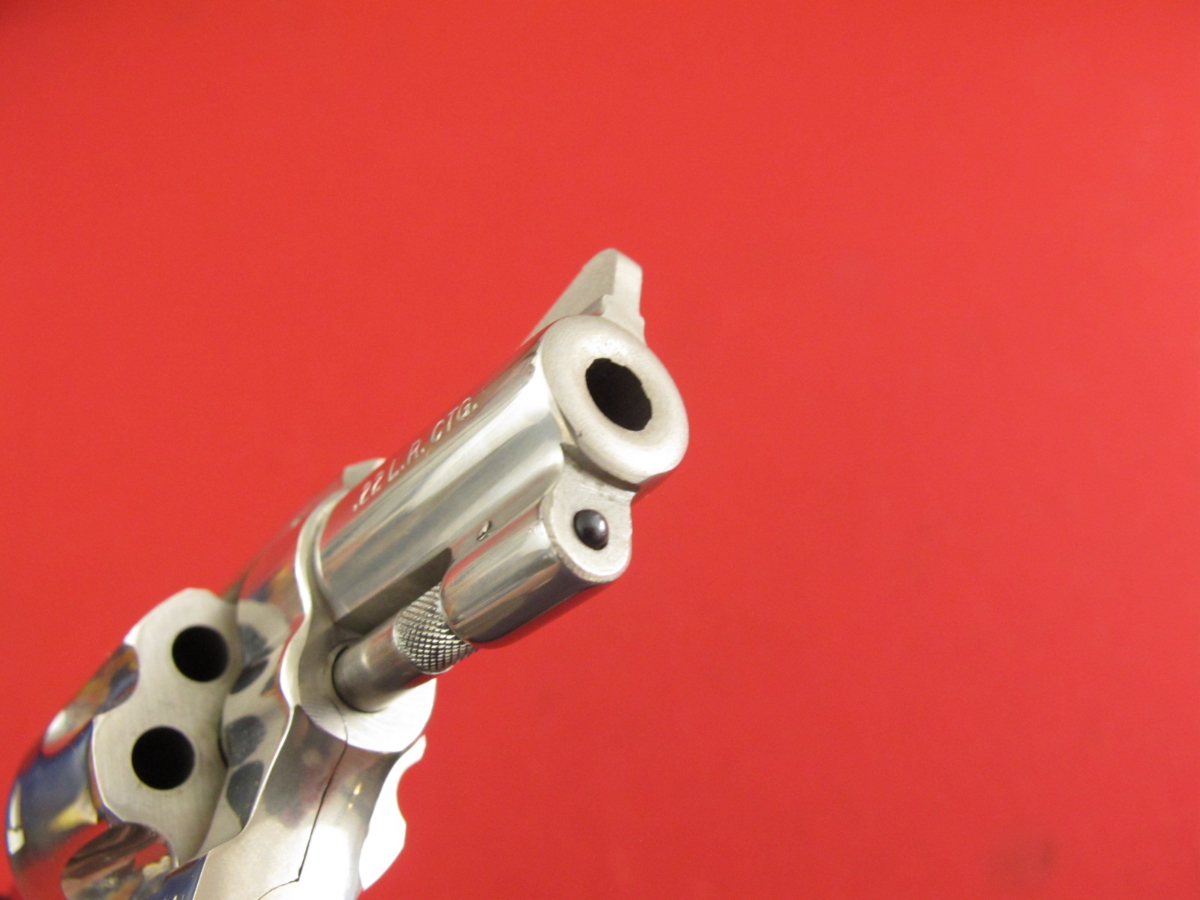
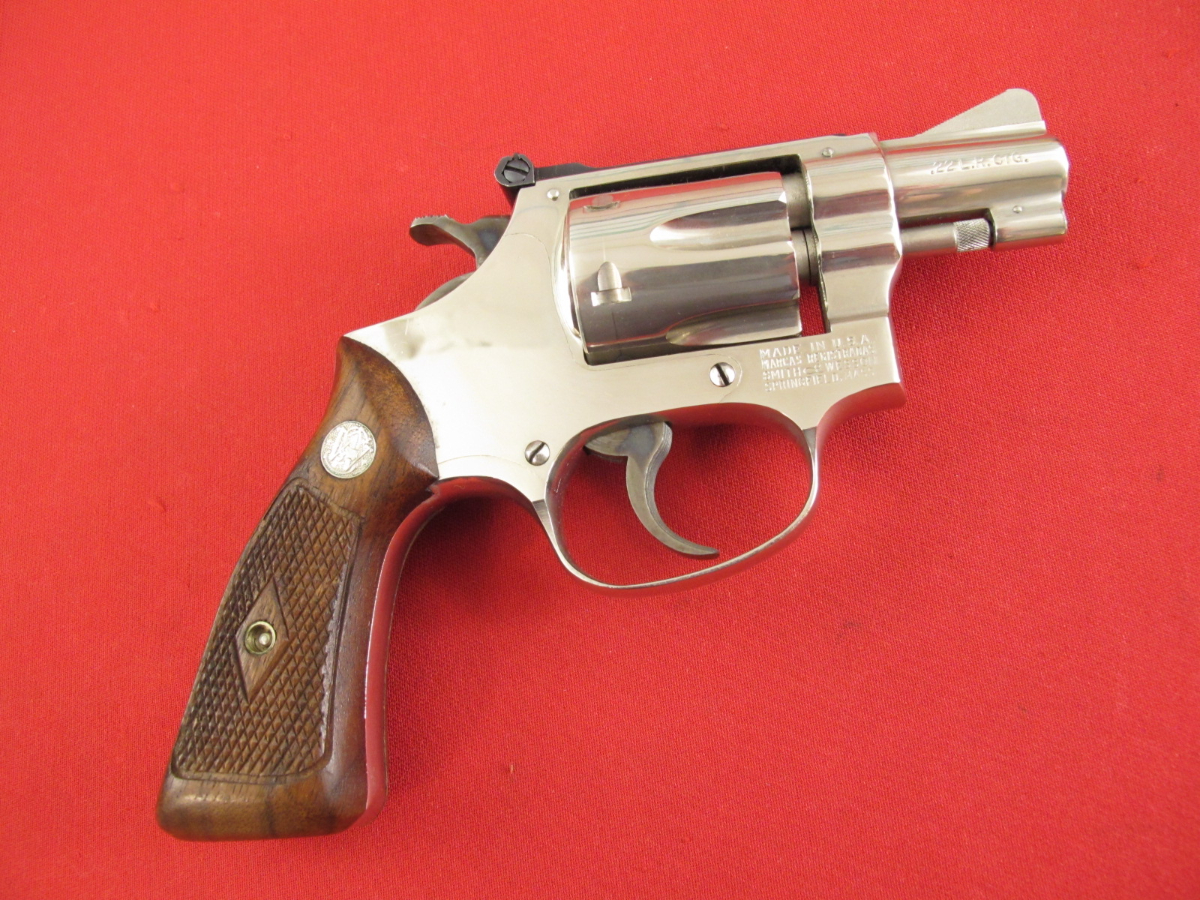

Maurice Rose was born in 1899 in Middletown, Connecticut, the son of Samuel and Katherin Rose. The son and grandson of rabbis from Poland, MG Rose was ultimately the highest-ranking Jewish officer in the United States Army. From the very beginning, Maurice Rose was a warrior.

Rose edited his high school paper and enjoyed a stellar academic career. In the yearbook published the year of his graduation a cartoon of the paper staff depicted him carrying a rifle. Soldiering was in his blood.

Rose lied about his age and enlisted in the Colorado National Guard hoping to participate in the Punitive Expedition against Pancho Villa. Six weeks later when his commander discovered that he was only sixteen he was discharged. Rose then worked in a meatpacking plant until he turned seventeen and could convince his parents to sign an enlistment waiver.

Once on active duty Maurice Rose’s natural leadership qualities became apparent. He was selected for officer training but had to illicitly alter his Army records to reflect a birthdate of 1895 so he would be old enough to be considered. In August of 1917 Rose graduated from the Officer Candidate Course at Fort Riley, Kansas. He was commissioned a Second Lieutenant just in time to deploy for World War 1.
LT Rose Goes to War

Rose made First Lieutenant in short order. His battalion assumed defensive positions in the vicinity of Toul, France in 1918. Soon thereafter Rose and his comrades found themselves in the thick of the Meuse-Argonne Offensive. This ghastly 6-week operation ultimately claimed a quarter-million casualties on both sides. More than 26,000 Americans were killed.

Rose, for his part, was in the thick of it throughout. He caught a load of shrapnel from a German mortar and suffered a concussion from nearby artillery fire. He refused the medics’ orders to evacuate until he eventually collapsed from exhaustion and blood loss. After a few days in the hospital, Rose slipped away to rejoin his unit.

This tidy bit of subterfuge resulted in his parents being informed that he was killed in action, an error that took a few days to rectify. Rose eventually recovered and served with the occupation troops until the summer of 1919 when he was discharged.
His True Calling

Rose worked as a traveling salesman for a time but returned to the military in 1920, as soon as the Army would allow it. By now he was a Captain and served in a variety of operational and administrative positions. At some point, he altered his military records once again and claimed to be Protestant. Though some biographers attribute this to a religious conversion, more than likely he simply felt that no longer being Jewish would help his career.

By the onset of World War 2 Rose was a Major and a graduate of the Infantry and Cavalry Officer Courses as well as the Command and General Staff College. He was soon promoted to Lieutenant Colonel. A preternaturally handsome man by the standards of the day, a newspaper reporter described him in print as “probably the best looking man in the Army.” That couldn’t do much for a guy’s humility.

In 1940 the US Army was a growth industry. The American military had to expand in an unprecedented fashion, and it needed experienced commissioned officers and NCOs desperately. By the time he saw combat in North Africa Rose was a full Colonel. He negotiated the surrender of German forces in Tunisia under Generalmajor Fritz Krause.

Operation Husky saw Rose promoted to Brigadier General during operations in Sicily. When the commander of the 3d Armored Division, MG Leroy Watson, was relieved in the summer of 1944 General Rose took his place and thrived.
The Character of the Man

MG Rose was known as an aggressive and effective combat commander. He once drove his jeep across a mined bridge to ensure it was safe for his men to follow. On another occasion, General Rose spotted a group of Germans running across a field and dove out of his jeep brandishing a Thompson submachine gun.

Along with his driver, his aide, his DivArty Commander, and a handy PFC this motley band promptly captured a full dozen German soldiers. The Division Commander subsequently marched his POWs back and turned them over to the MPs. Such antics endeared Rose to the troops in his command.

MG Rose indeed insisted on leading from the front but also eschewed the publicity, fame, and glory so many of his counterparts feasted upon. Unlike Generals like Patton, MacArthur, and Montgomery, Maurice Rose was satisfied to avoid the limelight and just do his job. This exceptional military ethic ultimately killed him.
Combat is a Chaotic Thing

On March 30, 1945, just over a month from the end of the war in Europe, MG Rose and his staff were traveling in jeeps at the head of a column of his 3d Armored Division near the city of Paderborn, Germany. The Germans were fighting on their home turf, and the situation was desperate. Armored units on both sides fought back and forth, creating a fluid, chaotic battlefield. When word reached Rose that certain of his units had been cut off by the Germans, he pressed forward to investigate.

Before they could react, Rose and the men of his armored vanguard began taking fire from German tanks, antitank guns, and small arms. The lead Sherman of his column was hit by an enemy tank round and destroyed. In response, Rose and his command team mounted their jeeps and attempted to flee cross-country.

The German tanks soon had the Americans outflanked, and they moved to seal off their escape. The lead jeep accelerated and narrowly avoided a Wehrmacht panzer to reach safety. MG Rose was in the second jeep and found himself cut off. The German Tiger pinned Rose’s jeep against a tree, forcing him to dismount.

While Allied troops had a tendency to describe all German tanks as Tigers, these were the real deal. Surviving American GIs identified the vehicles based upon their distinctive twin exhausts.

The German tank commander opened his hatch and emerged with an MP40 submachine gun. As the Wehrmacht soldier covered Rose and his small party, the American General reached for his sidearm. Whether or not MG Rose was attempting to surrender or intended to fight the German officer has been lost to history. The panzer commander leveled his 9mm SMG and shot Rose fourteen times in several bursts. The American General was dead where he fell.
The Gun

The German MP40 began life as the MP38 designed by Heinrich Vollmer in, you guessed it, 1938. The MP38 was an evolutionary development of the previous MP36. Not more than a couple of MP36’s survived the war. The MP38 featured a machined steel receiver and bakelite furniture. It can be differentiated from the subsequent MP40 by the longitudinal ridges in the receiver and a small hole pressed into each side of the magazine well.

The MP40 was a very similar design and enjoys essentially complete parts interchangeability with the MP38. Both guns feature a novel but unnecessarily complicated telescoping recoil spring system that makes the guns exceptionally smooth in action. The MP40 was the first general-issue Infantry weapon truly optimized for mass production. Around a million copies rolled off the lines before it was supplanted by the MP44 assault rifle. The MP40 soldiered on until the very end of the war.
The MP40 in Action

I have a friend who was walking point with a buddy on a patrol through a German village in the final days of the war. Coming around a corner he and his pal came face to face with a German soldier armed with an MP40. The kraut soldier loosed a burst into the chest of my friend’s comrade. My buddy killed the German with a burst from his Thompson.

Both Americans retreated into a nearby building. The wounded American then leaned heavily against the wall, slid to the floor, and died. Even well into his nineties that remained a difficult story for my buddy to tell. At close range, the MP40 was a proven man-killer.
The Rest of the Story

The victorious Allies undertook an investigation to determine if MG Rose’s death might constitute a war crime. He was the highest-ranking American soldier to be killed in action in Europe, and his Jewish heritage made the circumstances of his killing immediately suspect. However, the light was dim at the time, and when his body was recovered the following day his codebook and maps remained unmolested.



MG Rose was ultimately shot with four separate bursts from that German tank commander’s MP40. The first burst knocked Rose’s helmet off. Four rounds from the third burst struck him in the head and killed him. His helmet was recovered from a nearby ditch about ten feet away. The holes in the helmet resulted from its having been hit as it spun in the air behind the dying General.


The determination was simply that MG Rose tragically fell victim to the fog of war. German troops were frequently inexperienced and terrified at this late stage. That nameless Wehrmacht tank commander likely just saw Rose move for his pistol and fired reflexively. MG Maurice Rose, known to his men as “The Division Point” because of his penchant for leading from the front, was buried at the US military cemetery at Margraten, the Netherlands. 3d Armored Division commanders rendered honors at his grave until the early nineties when the division was disbanded.


One of the most daunting things when I first started looking for a gun was…what size bullet to get?
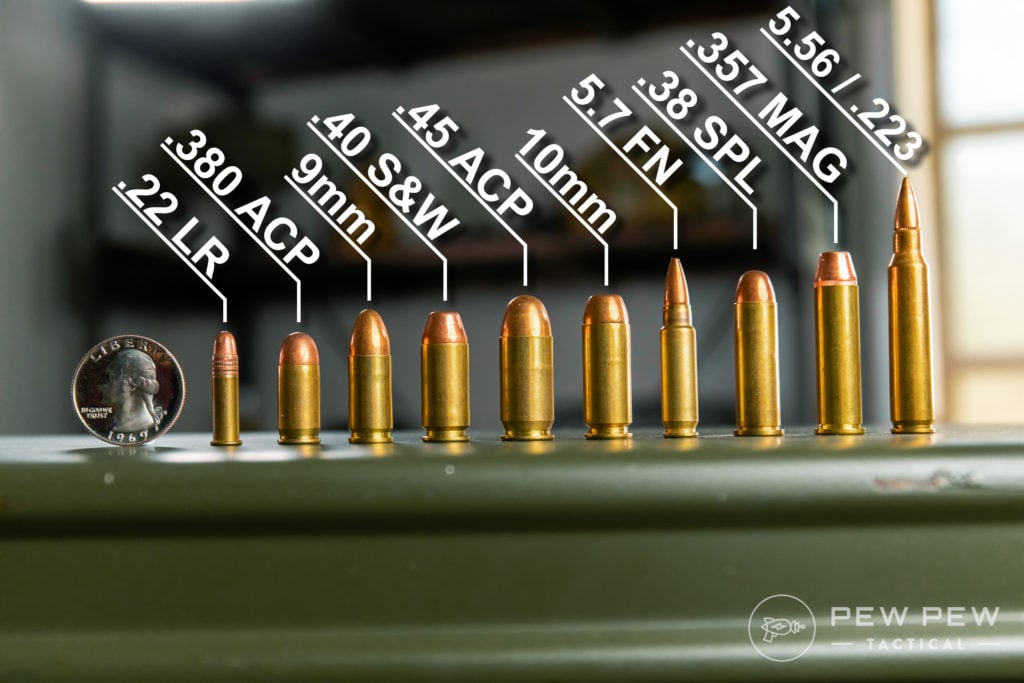
Things got even crazier when I started to look at rifles…
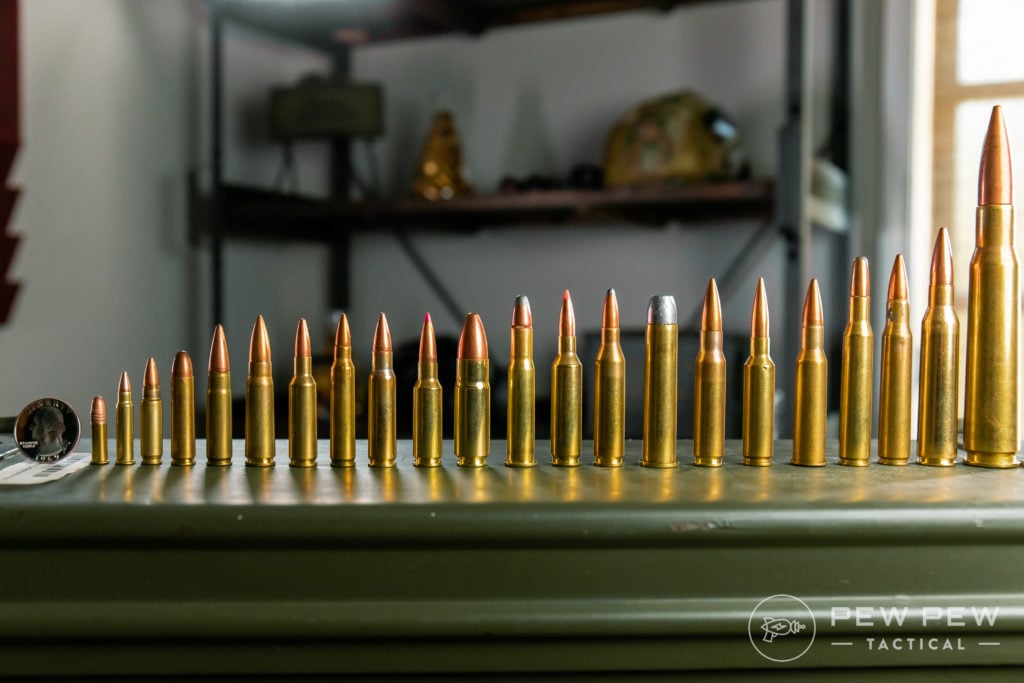
But don’t worry…we’ll be covering some of the most popular handgun, rifle, and shotgun calibers out there.
As well as the benefits and weaknesses of each.
Then we’ll follow up with some bullet terminology and the different types of bullet tips (hollow point, etc), how shotgun shell sizes work, and a breakdown of the components of a round.
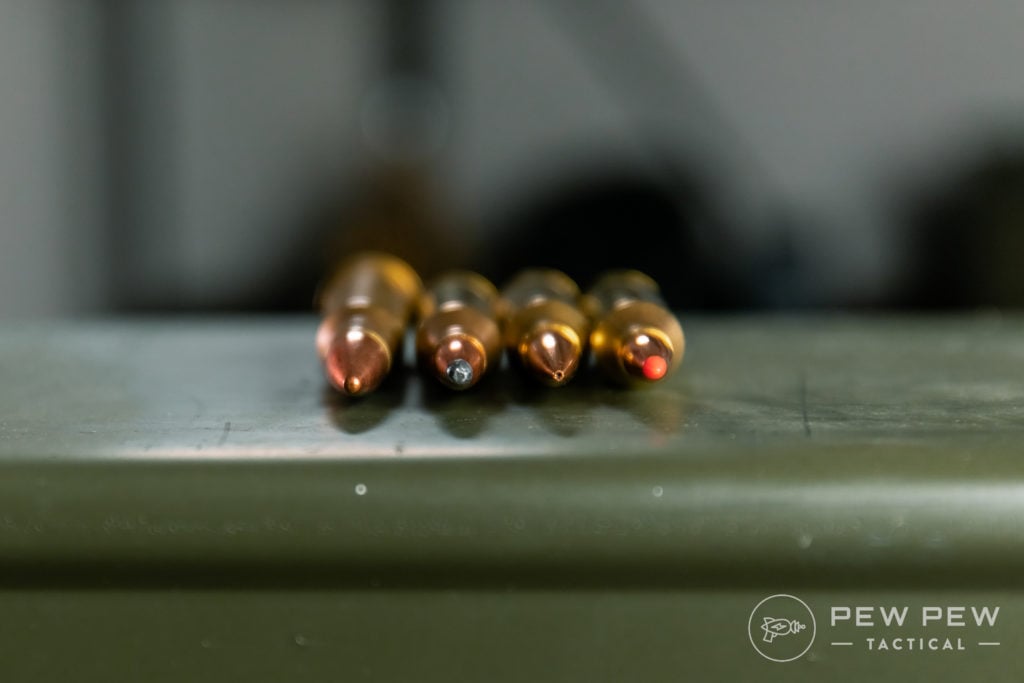
By the end, you’ll be a bullet pro!
Table of Contents
Bullet Size & Caliber
First!
For guns, “caliber” means the diameter of the barrel and thus the diameter of the bullet that is going through it. Usually in inches or mm.
Also for terminology’s sake, “bullet” just means the metal projectile, while the entire thing is called a cartridge.
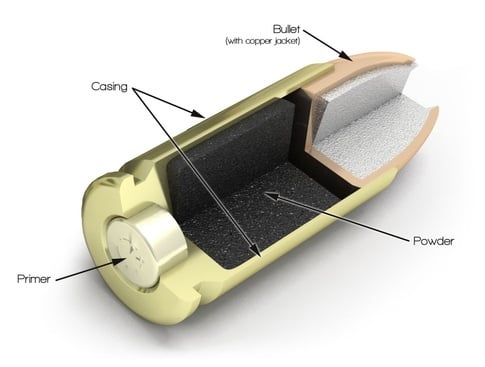
Here are some common 9mm bullets.
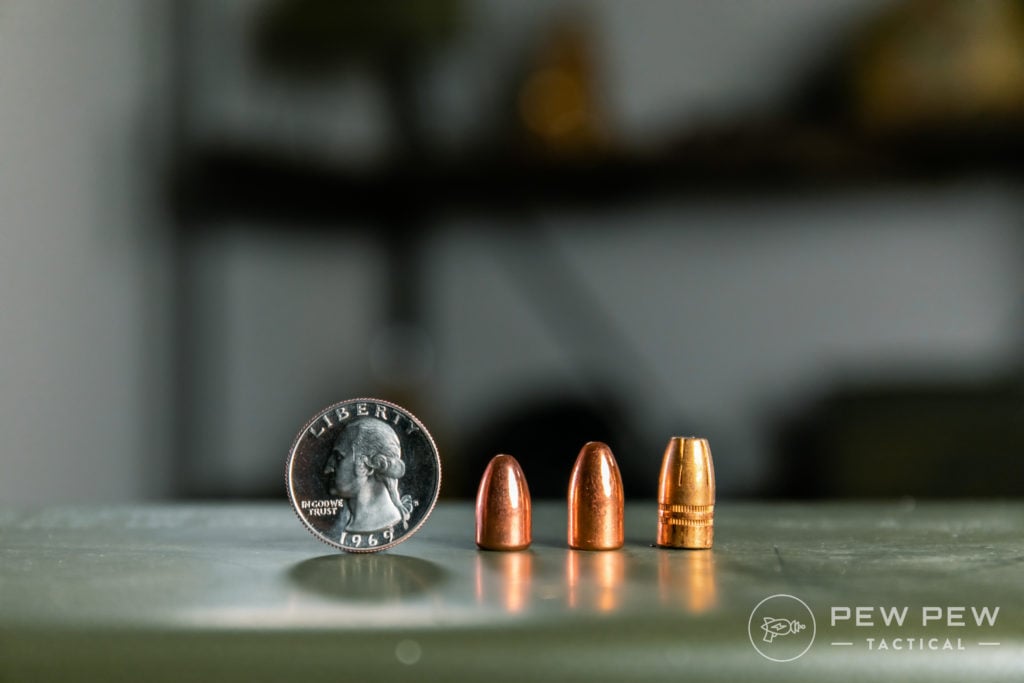
If you want to jump ahead, check out our suggestion for the Best Places to Buy Ammo Online.
Now what you’ve been waiting for…
Rimfire vs. Centerfire
The first differentiator is between rimfire and centerfire cartridges.
The rimfire’s primer is built into the rim while the centerfire cartridge has the primer in the center. Pro tip…if you can see a circle in the middle…it’s a centerfire cartridge.
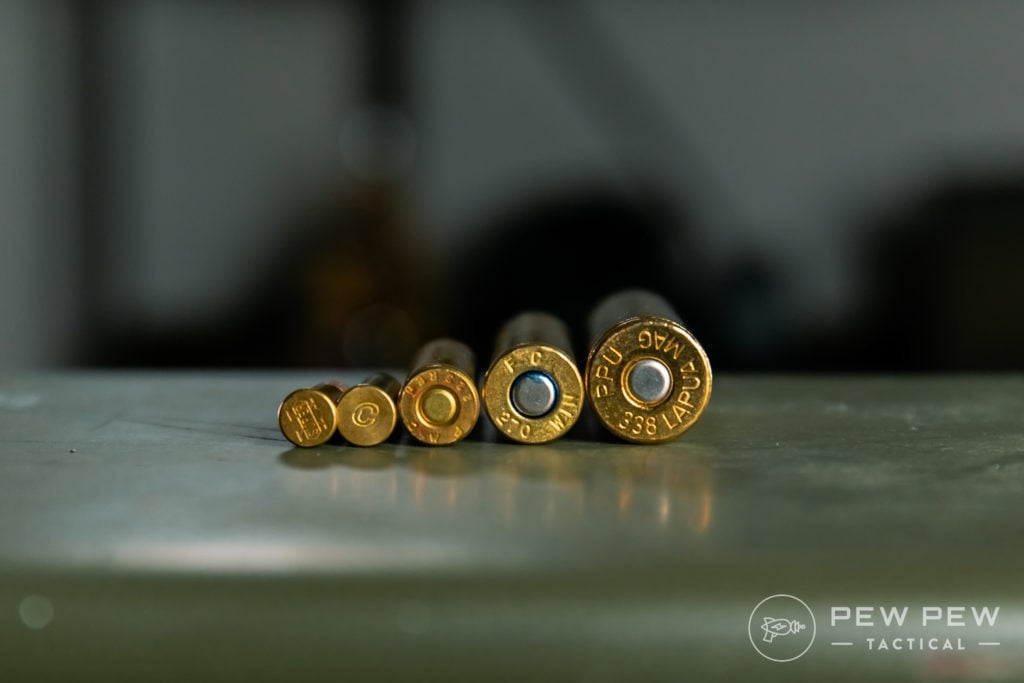
Rimfires are extremely cheap (a few cents each) and the .22 LR is the most popular rimfire caliber.
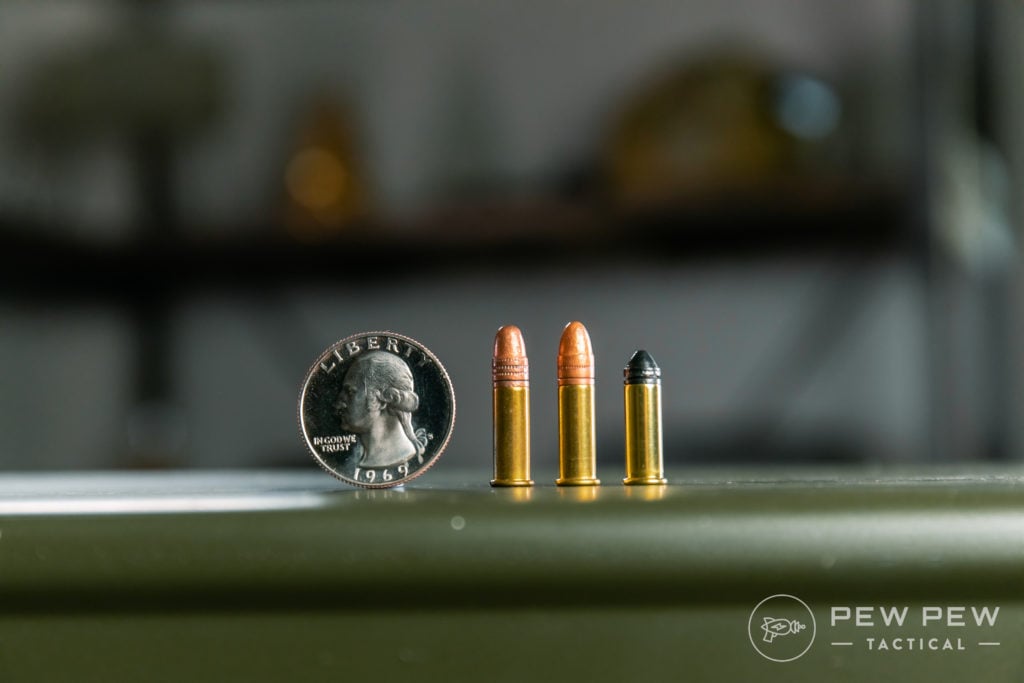
This animation shows how the firing pin hits the primer in a cartridge.

Here are some expended casings from a rimfire vs centerfire.
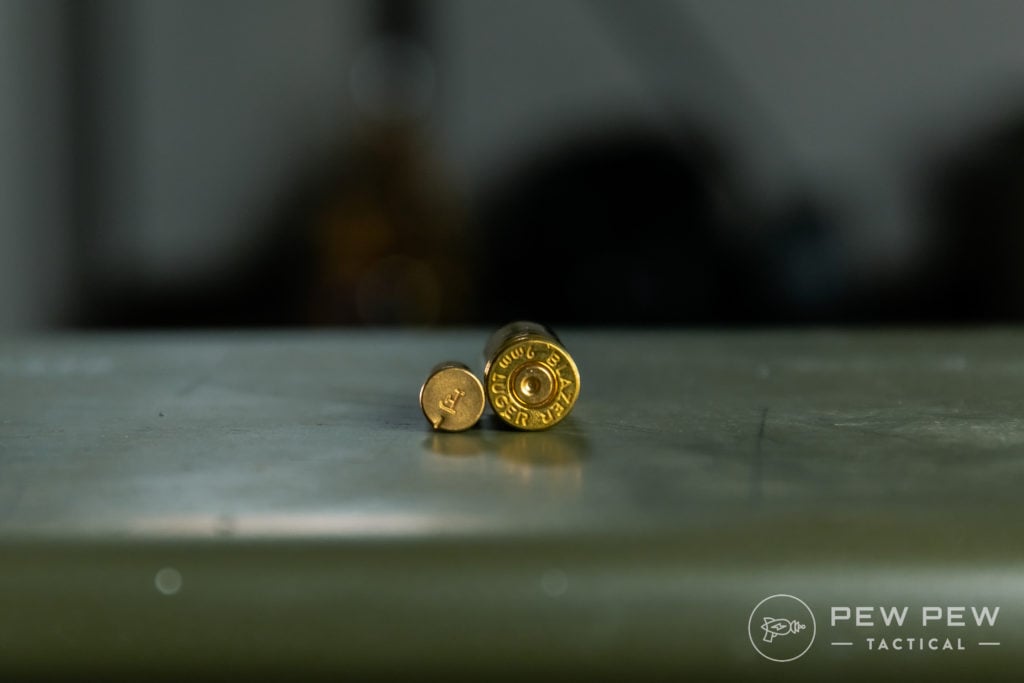
For even more differences, see our article on Rimfire Ammo or familiarize yourself with How Guns Work.
Common Bullet Calibers
To make things a little more confusing, there’s a mixture of measurements in inches and millimeters.
There’s also a unit of weight called a “grain” which is used to denote the weight of bullets and gunpowder. A “grain” is really small since 7,000 grains make up one pound.
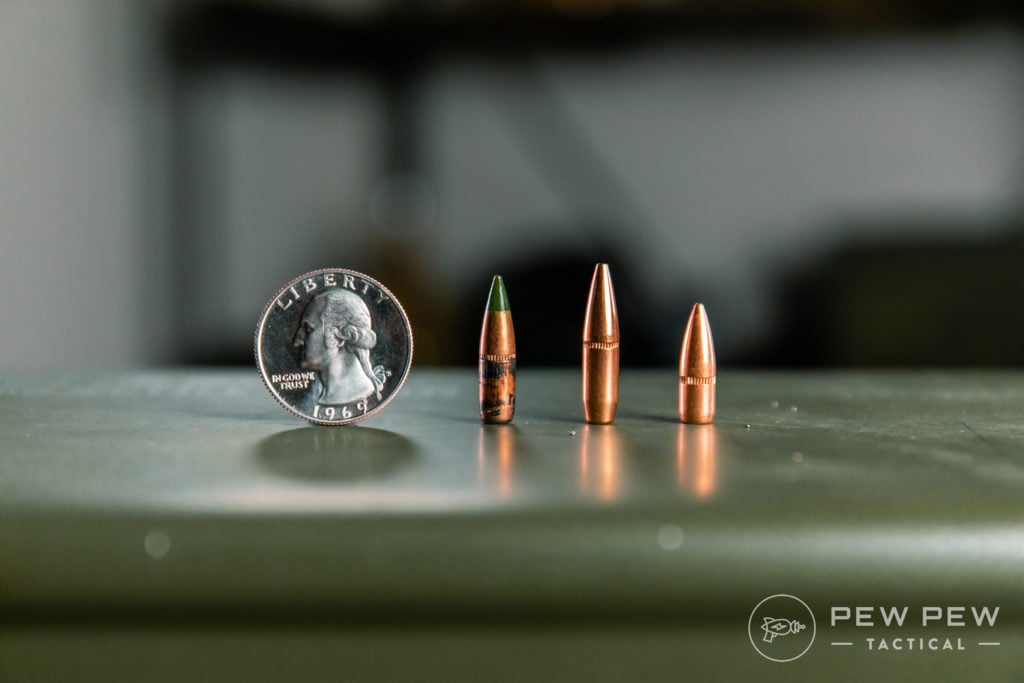
Now let’s go through some!
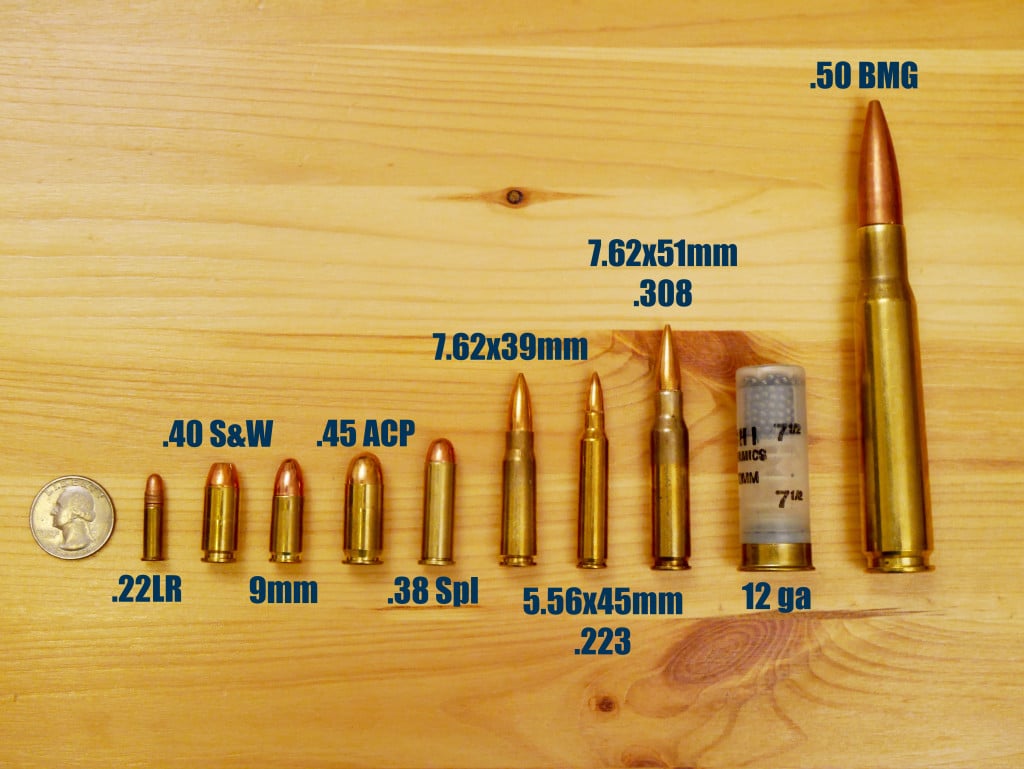
.22 LR
The “twenty-two” long-rifle is the most common caliber in terms of units sold.
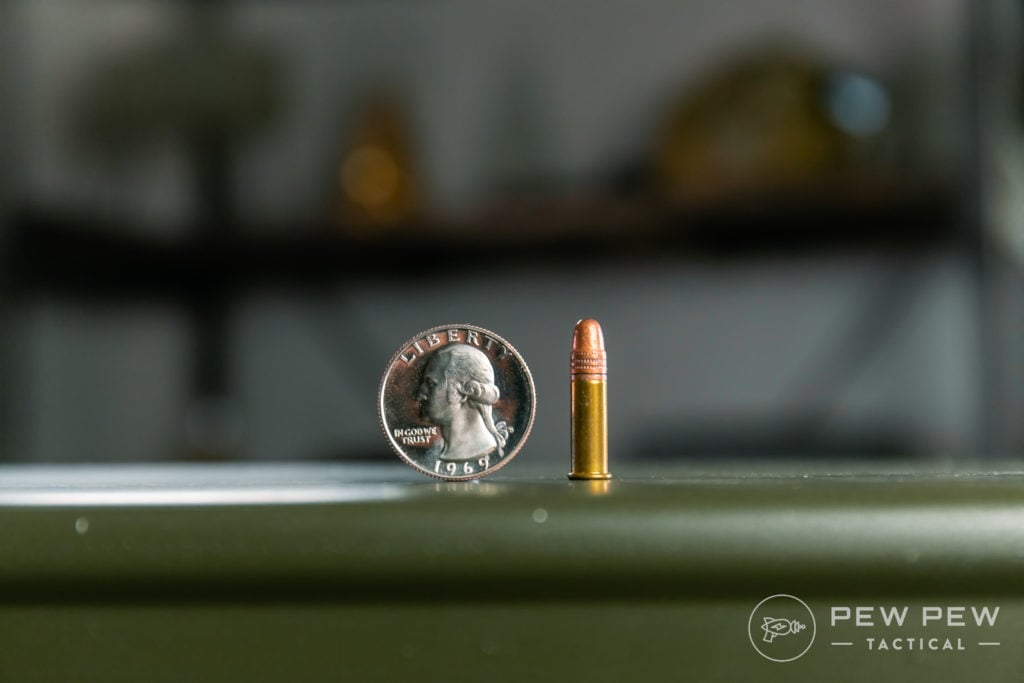
It has a bullet weight of around 30 to 40 grains and is extremely mild shooting in both pistols and rifles.
The recoil is almost non-existent which makes it a great starter round for someone who has never shot a gun or is uncomfortable with the noise.
The low price of the bullets is also great for learning sight pictures.
It is traditionally the starting caliber for shooters. These things are only a few steps up from a pellet gun round…especially in a rifle (Ruger 10/22) shown below.
They can kill, don’t get me wrong, but they’re mostly for killing rats, snakes, and birds. They’ll kill an attacker for sure but it might take a shot or six.
For more info:
.380 ACP
Now we’re getting into slightly beefier sizes.
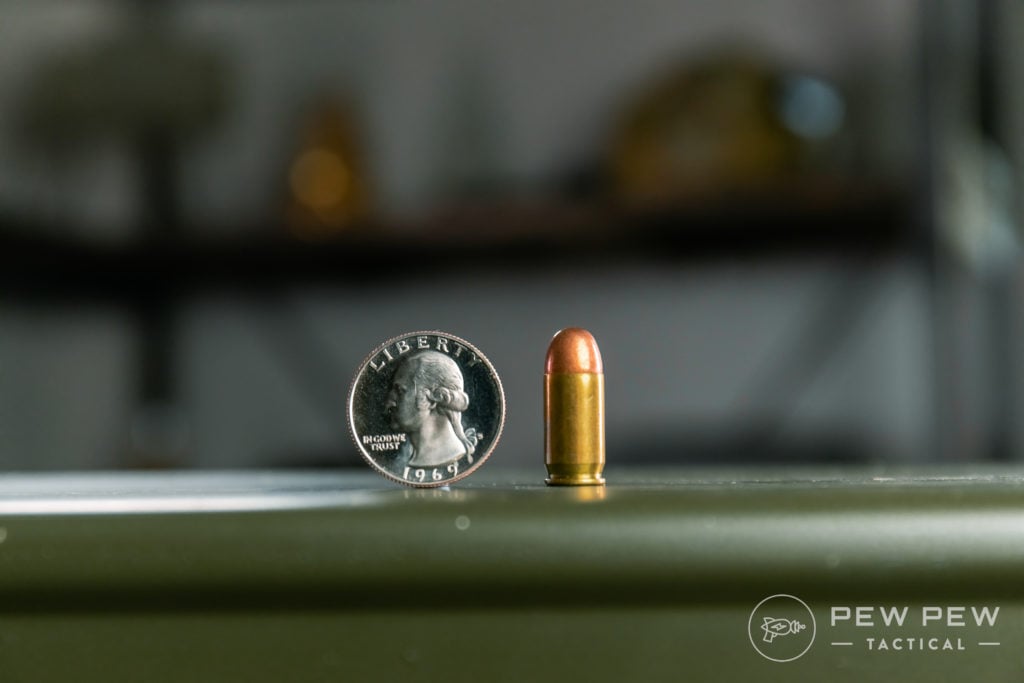
Personally, I would never use a gun with anything smaller than a .380 as my primary carry weapon.
Sometimes called a “9mm Short”, it has seen a major boost in popularity recently thanks to the various “pocket pistols” that have come on the market.
This bullet has relatively low recoil and, at close range, good penetration.
Gun author Massad Ayoob once said of the .380, “Some experts will say it’s barely adequate, and others will say it’s barely inadequate.” This is a low power round.
Because of the nature of the bullet and the guns that shoot it, it’s going to be relatively useless beyond close-ish range.
For more info:
9mm
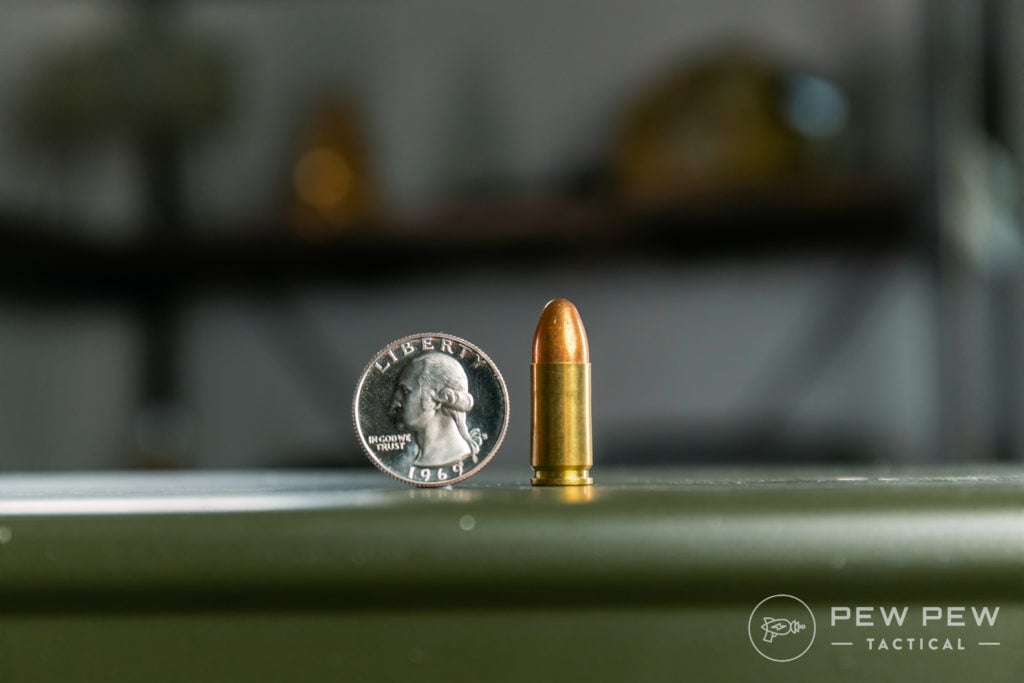
This pistol round is officially known as the “9x19mm Parabellum” or “9mm Luger” to distinguish it from other 9mm rounds. But you will be fine just saying “nine millimeter” or “nine mil” for those in the know.
9mm is my personal favorite and if there was a “Goldilocks” round, this would be it.
The very first gun I bought was a 9mm.
They’re fun at the range. They’re good for defense.
Believe it or not…or actually believe it because it’s true…the 9mm bullet is the same diameter as the bullet used in the .380 and the .38 Special.
The difference between the three is the amount of gunpowder behind it and possibly bullet weight.

It is the standard round for NATO countries and the majority of police forces around the world.
It is mild shooting, can vary in weight from 115 to 147 grains, and has varying stopping power based on the type of bullet (hint, go with hollow points).
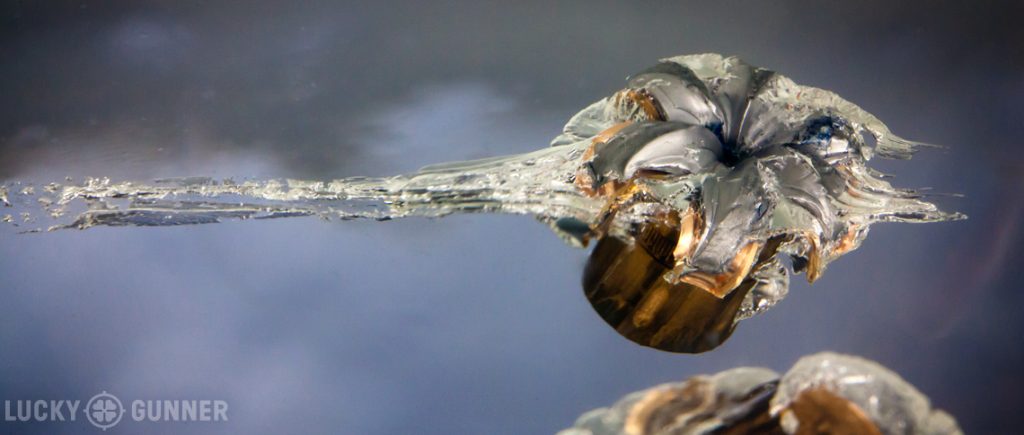
Many, many guns use this size as well. A compact 9mm gun can be used for concealed carry. Most of the guns that use this size can hold on average 15 to 17 rounds in the magazine.
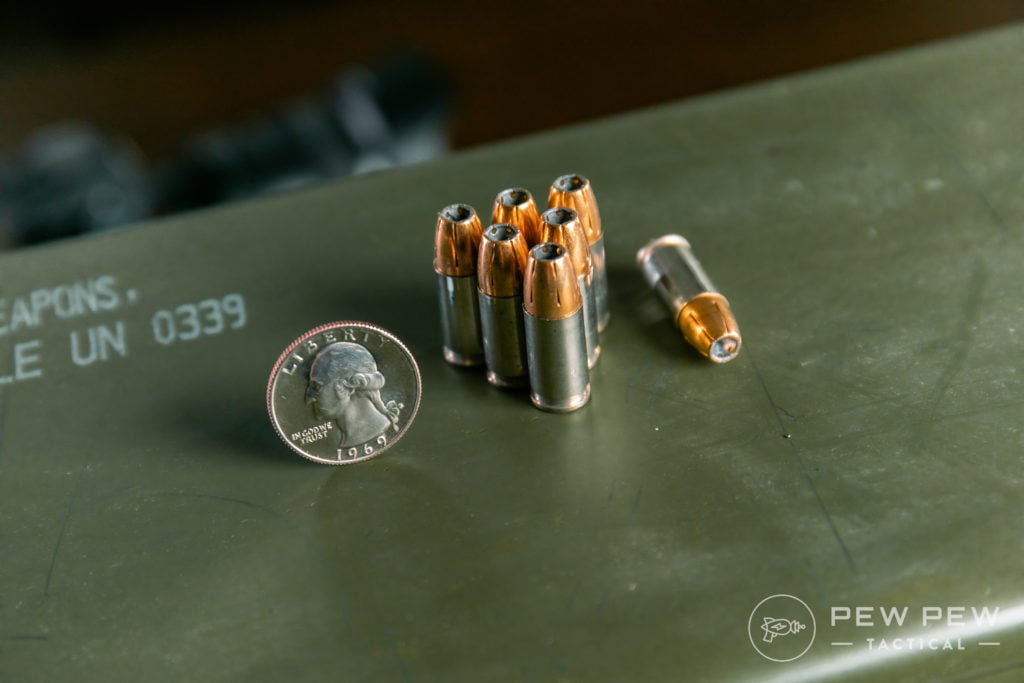
And now…there’s been a huge rise in popularity of Pistol Caliber Carbines (or PCC). Get the nice ergonomics of a rifle but with the price and hollowpoints of the 9mm.
For more info:
.40 S&W
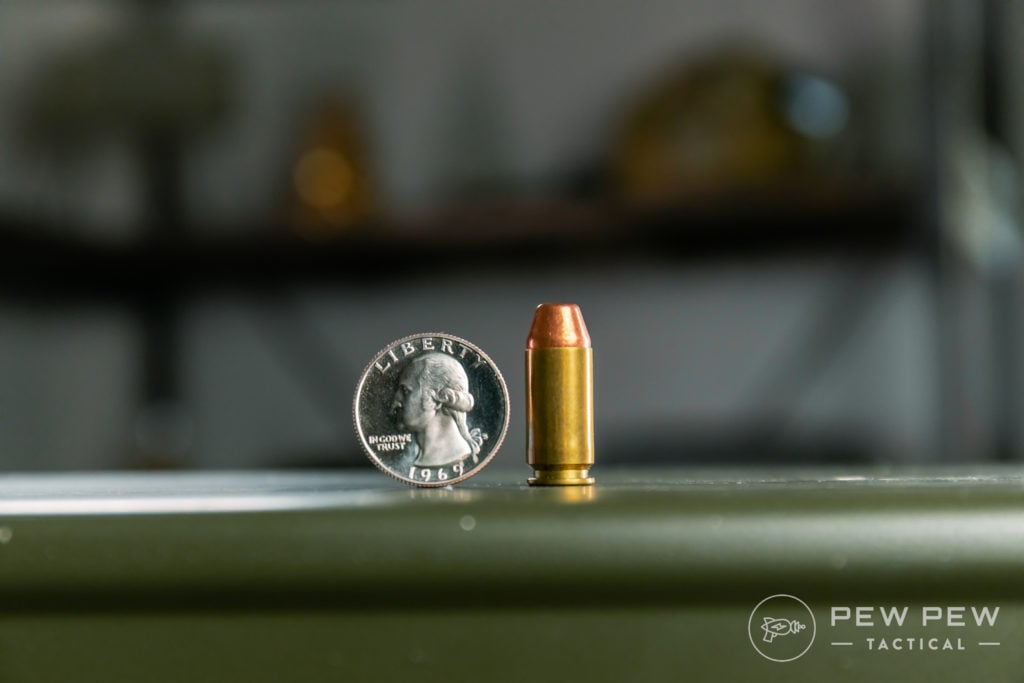
Remember how I said the 9mm was the “Goldilocks Round?” If that’s the case then the .40 is her big, angry, whiskey-drinking sister.
Originally designed for the FBI as a reduced 10mm cartridge and popular with other law enforcement agencies ever since. More kick when compared to the other popular handgun cartridge, the 9mm. Weights of the bullet can vary from 155 to 165 and 180 gr.
Note that the FBI recently decided to move back to the 9mm since agents are able to shoot more quickly and more accurately with 9mm compared to the .40 S&W.
For more info:
.45 ACP
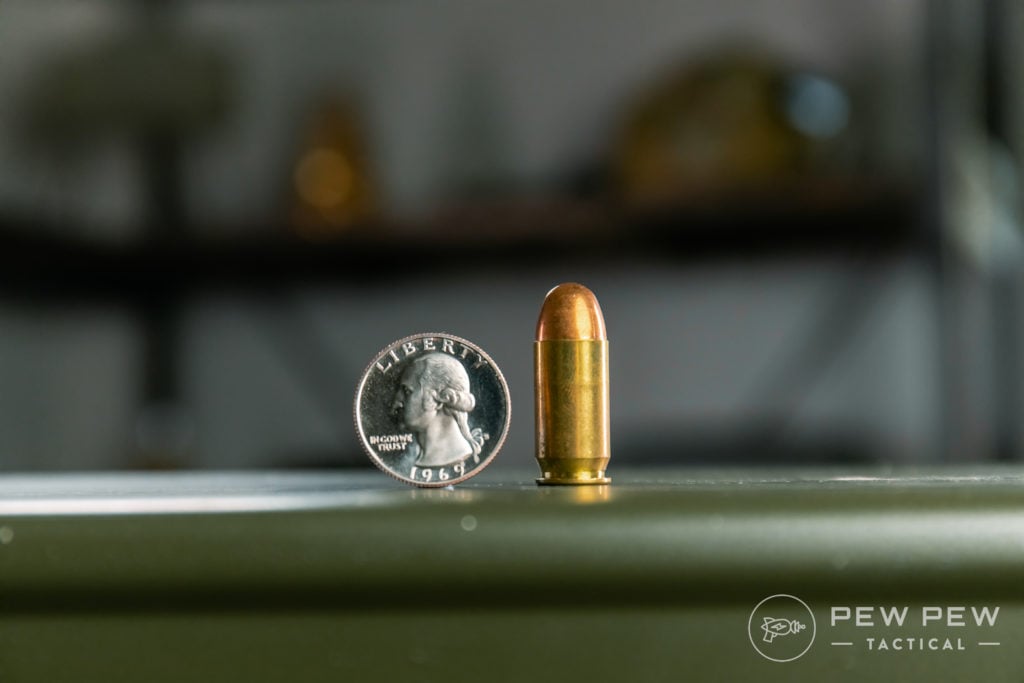
Designed in 1904 by Mr. John Browning himself for the famous 1911 pistol, this round has one heck of a history.
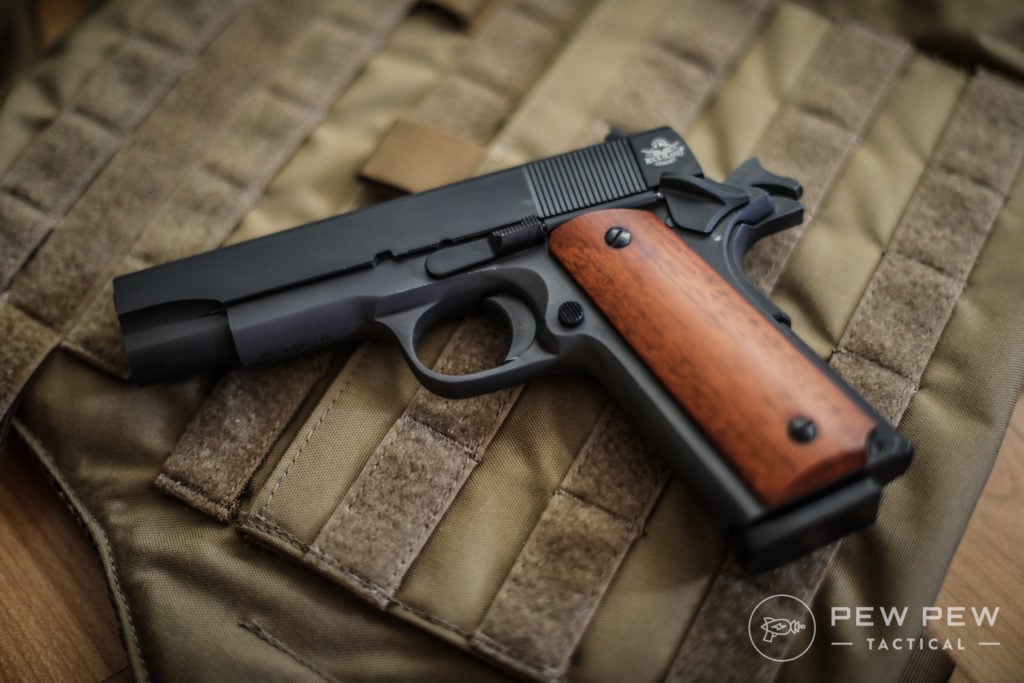
This thing is a big bullet with stopping power to spare.
The choice of many police officers and military personnel for years, the .45 caliber round has proven itself time and time again. I could probably do an entire article on just this bullet.
It has a large bullet of around 230 grains and has moderate recoil.
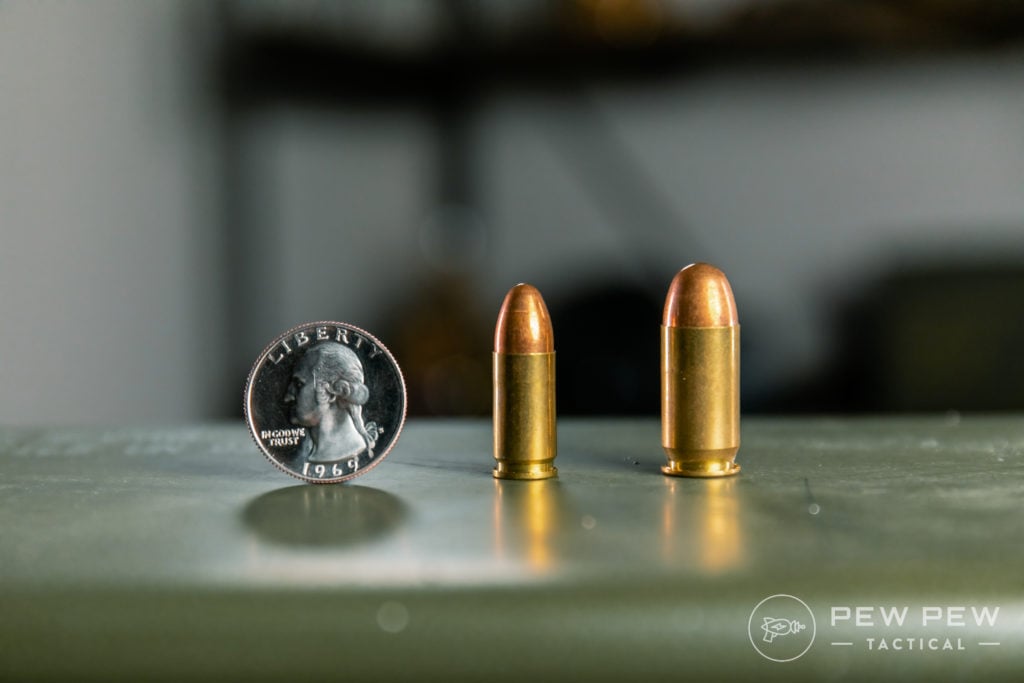
I can tell you from personal experience that this is not a round to hand to someone who’s never fired a gun before. Its stopping power is renowned and has a nostalgic following.
For more info:
.38 Special & .357 Magnum
The “thirty-eight special” is most commonly found in revolvers.
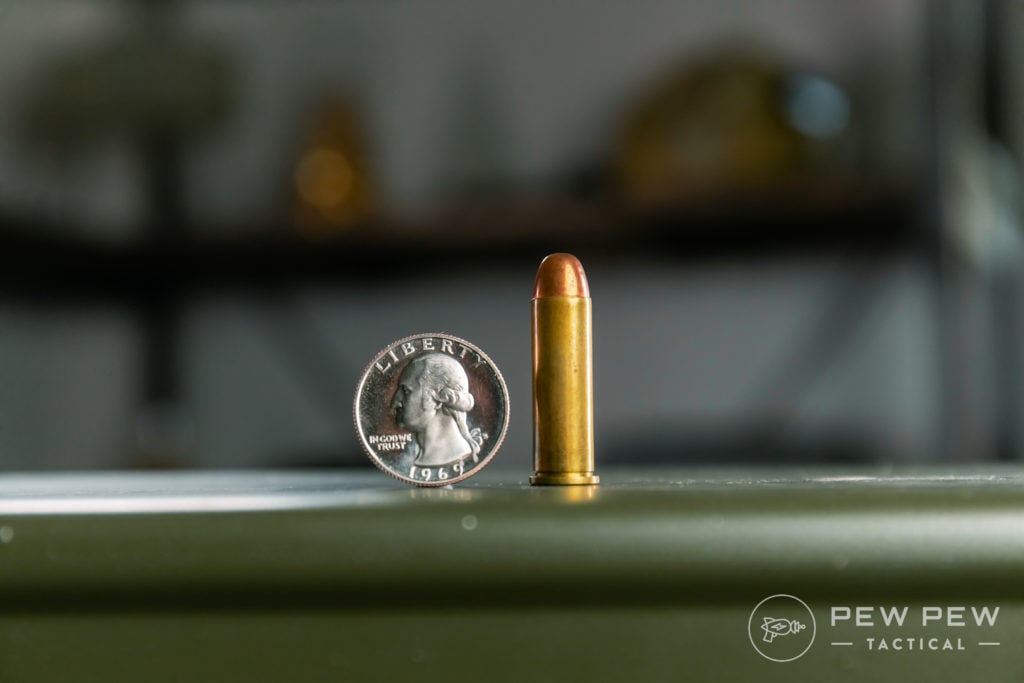
It has manageable recoil but is still quite a handful when in a very light/small revolver. It has a longer cartridge and more powder in said cartridge but it is a slower, heavier bullet than the 9mm.
The FBI used this cartridge as its standard issue for a very long time.
The .357 Magnum is identical to the round except for being slightly longer.
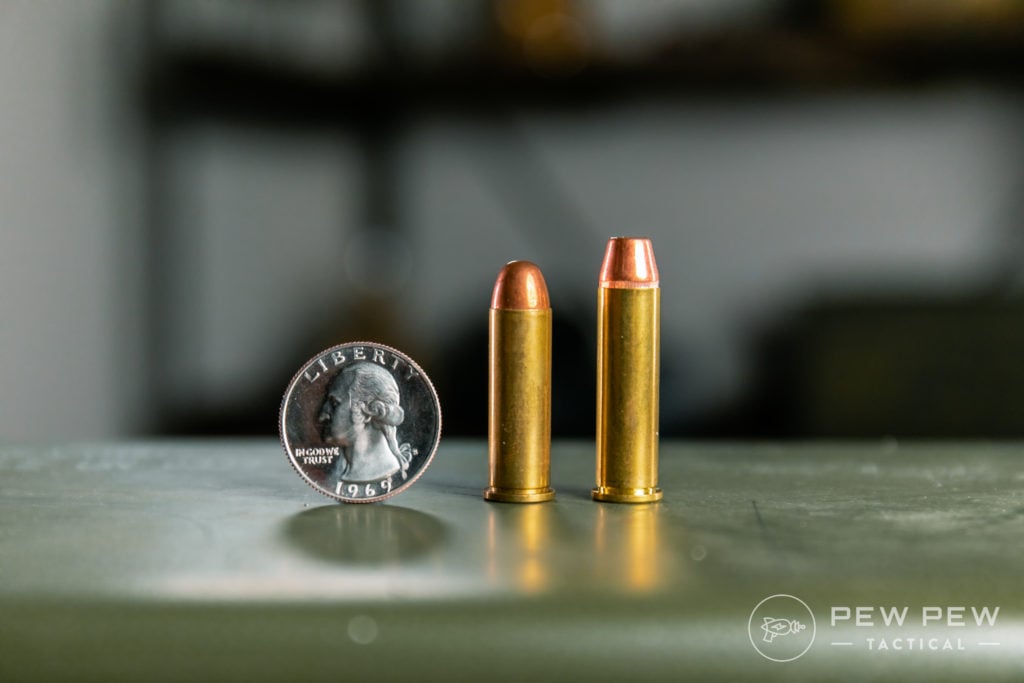
You can safely fire a .38 Special in a .357 Magnum gun, but don’t try the other way around due to size and pressure constraints.
Bullet weights vary from 110 to 132 to 158 grains.
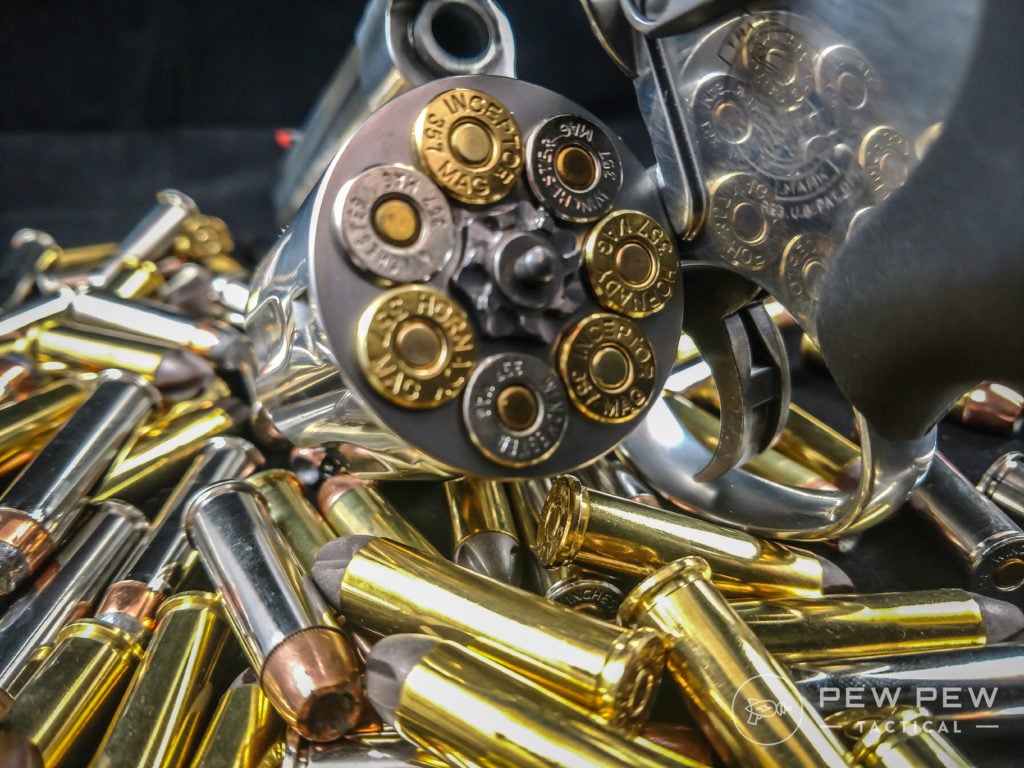
For more info:
7.62x39mm
This is the Soviet round used in the AK-47 line of rifles.
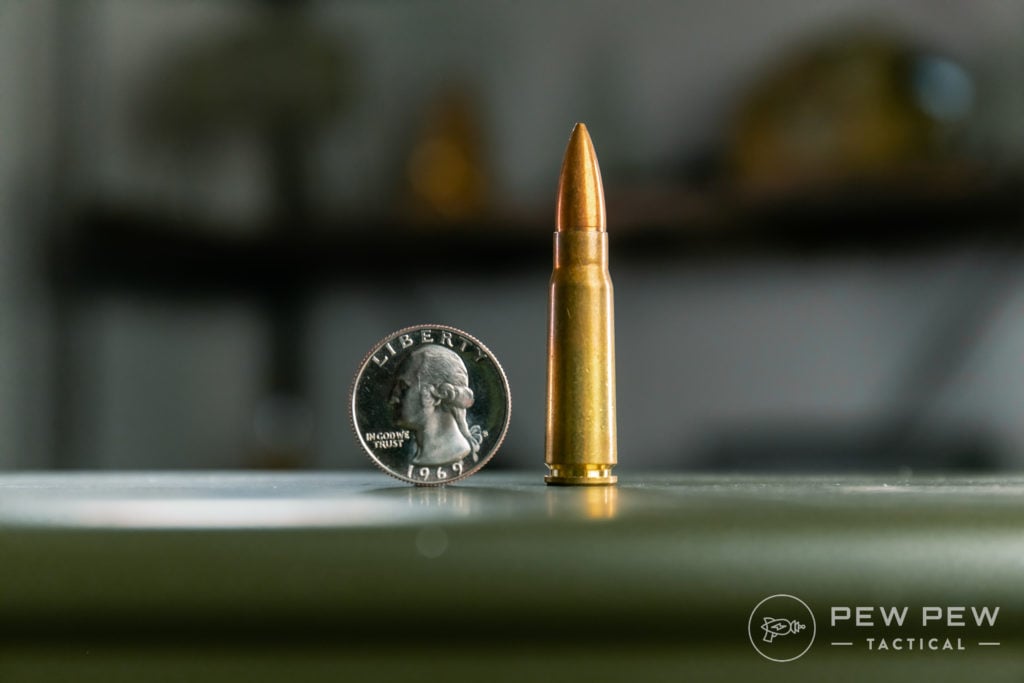
It has moderate recoil, great knockdown power, and a bullet weight of usually 123 grains.
There is a high availability of military surplus ammo which makes the round very affordable. Plus check out its bullet size vs the 5.56 coming up next…
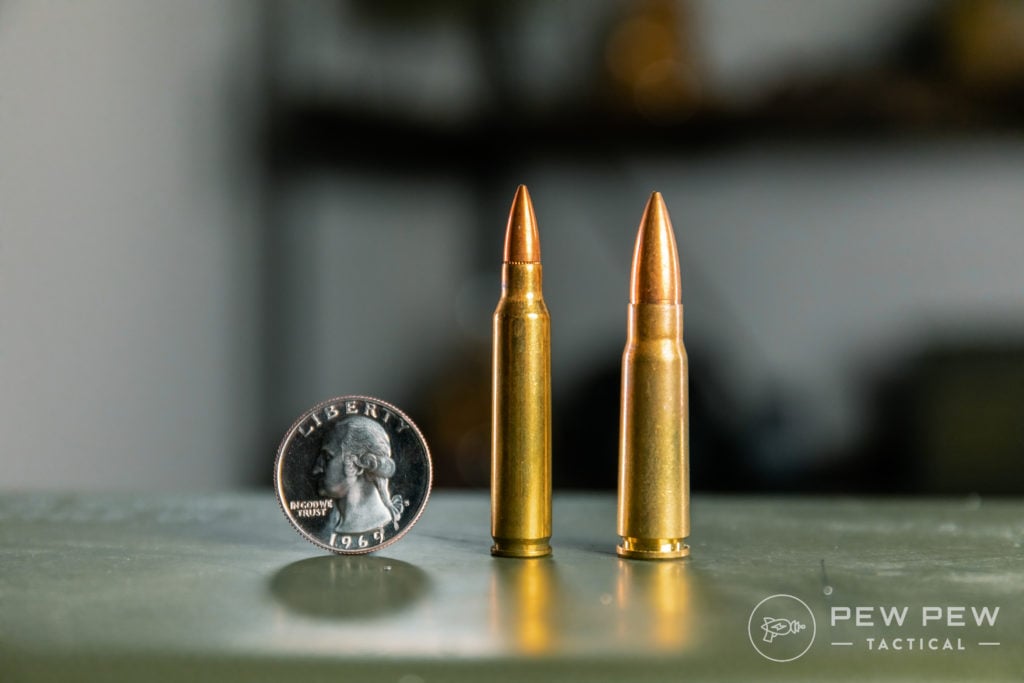
For more info:
.223 / 5.56x45mm
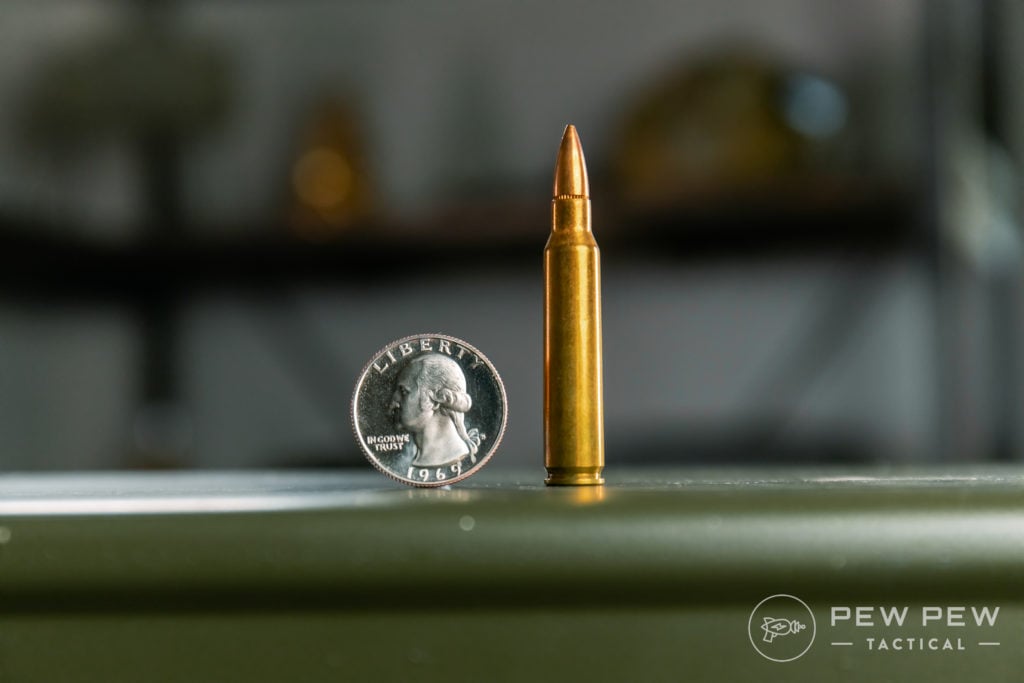
The “two-two-three” (inch) Remington has almost the exact dimensions as the “five-five-six” (mm) NATO cartridge.
The 5.56 has higher pressures than the .223, so .223 rounds can be fired in a 5.56 rifle, while 5.56 rounds should not be fired in a .223 rifle.
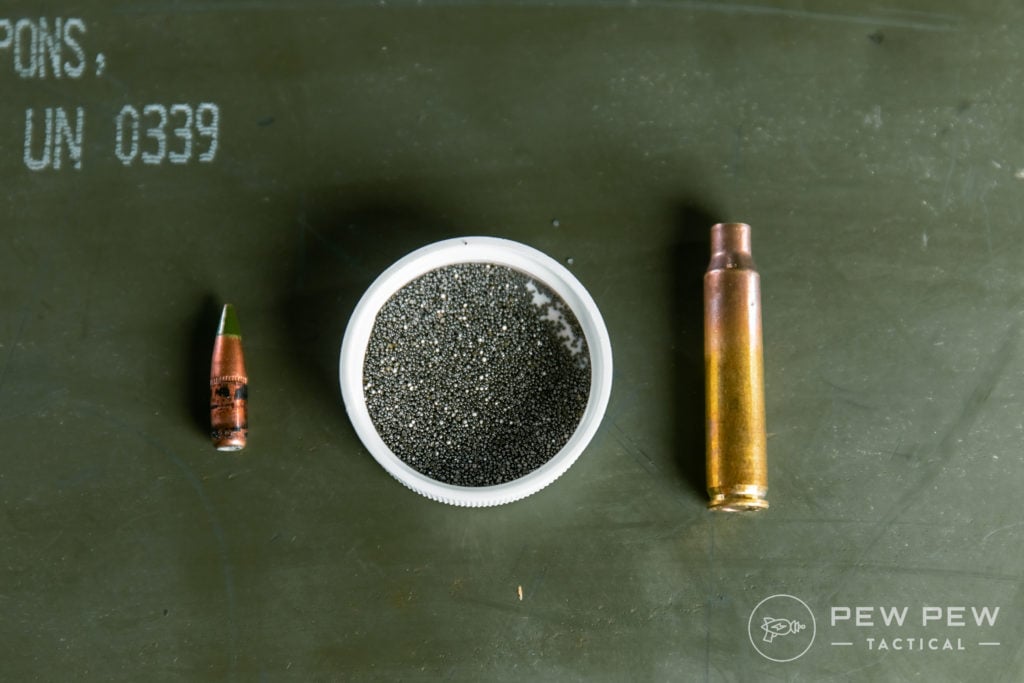
Bullets are around 55 grains and the cartridge has light recoil.
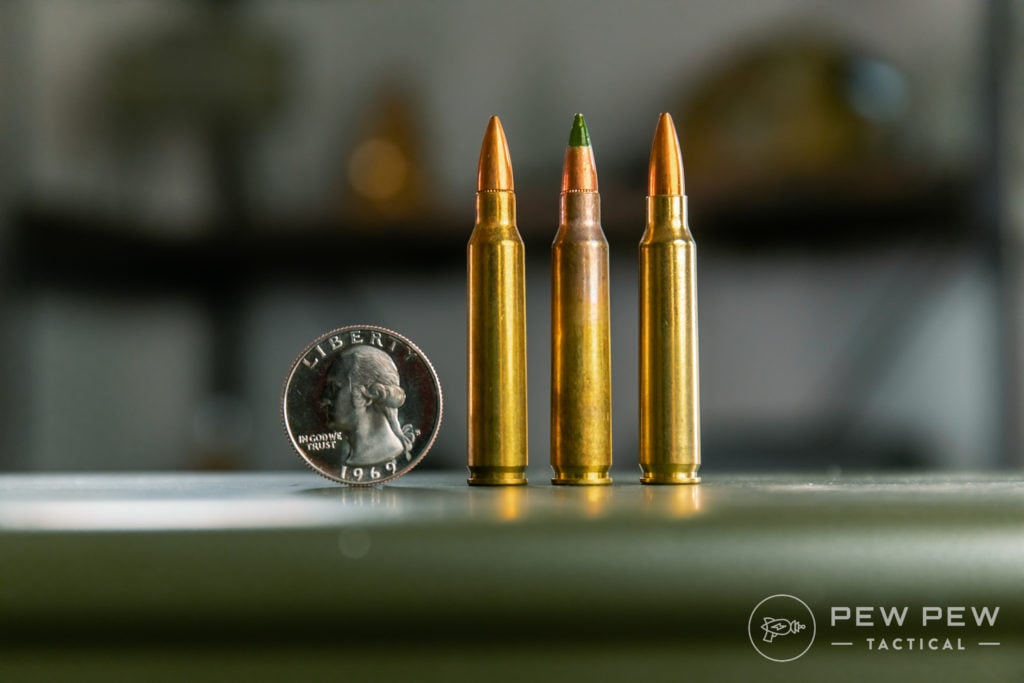
It is the ammunition used in the M16/M4/AR-15 line of rifles and there’s still endless debate on its effectiveness in combat.
For more info:
.308 / 7.62x51mm
The “three-oh-eight” (inch) Winchester is almost the same dimensions as the “seven-six-two” (mm) NATO round.
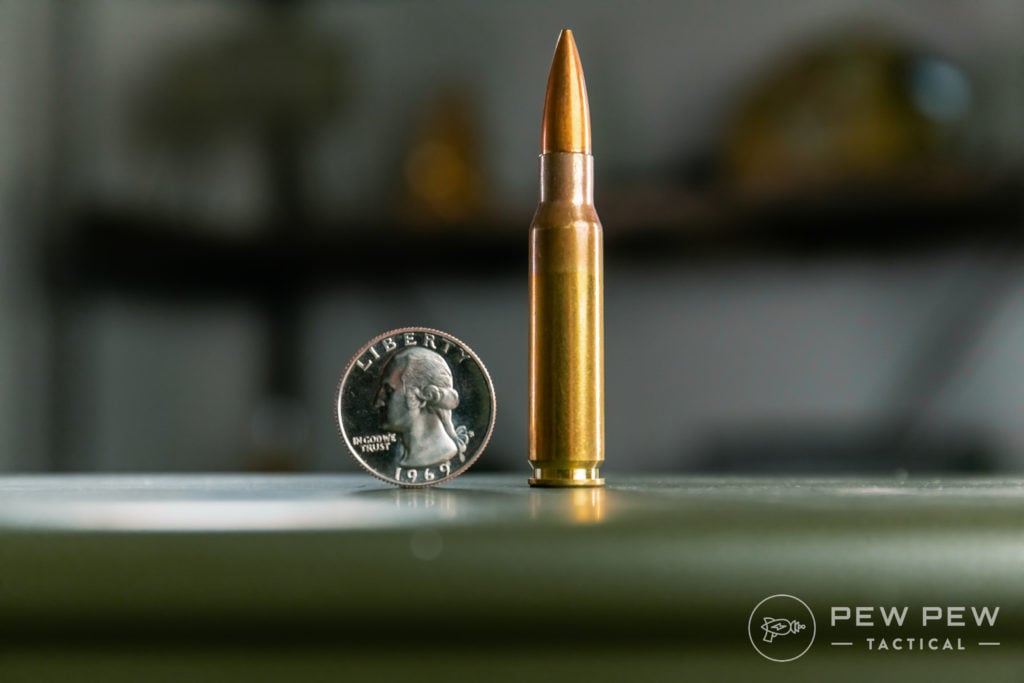
There are special considerations when mixing the rounds but unless you know what you are doing, stick with the round intended for your rifle.
It is a popular hunting round with moderate recoil, high stopping power, and a wide range of bullets available from 150 to 208 grains.
Plus…one of the most popular heavier caliber machine gun and sniper rounds for many militaries around the world.
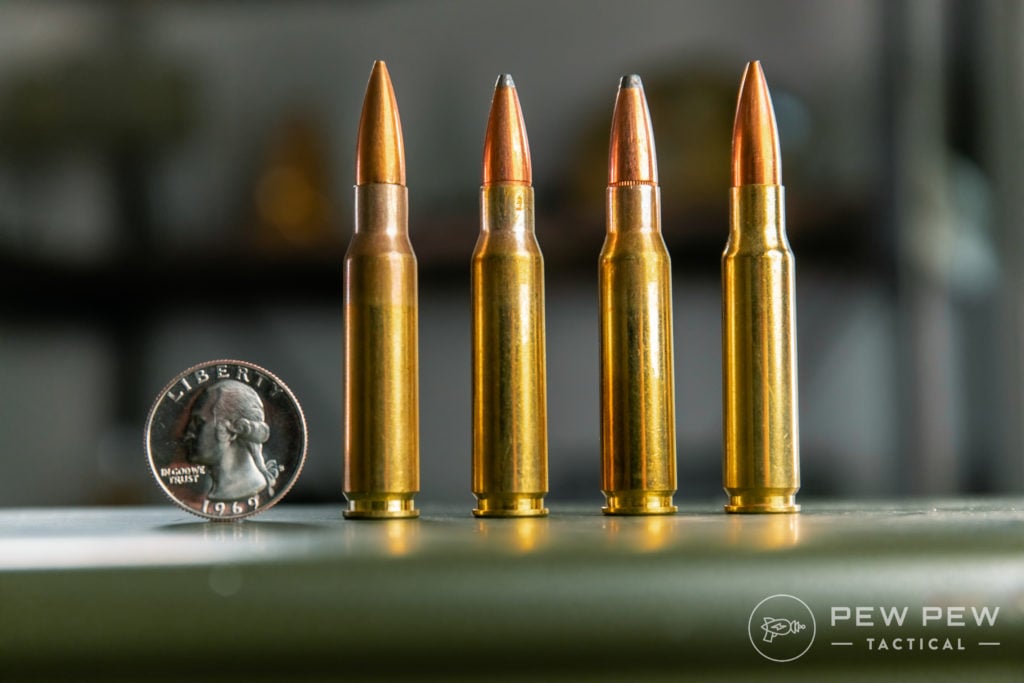
For more info:
.50 BMG
Not really common for civilians, but I just had to have it in here.
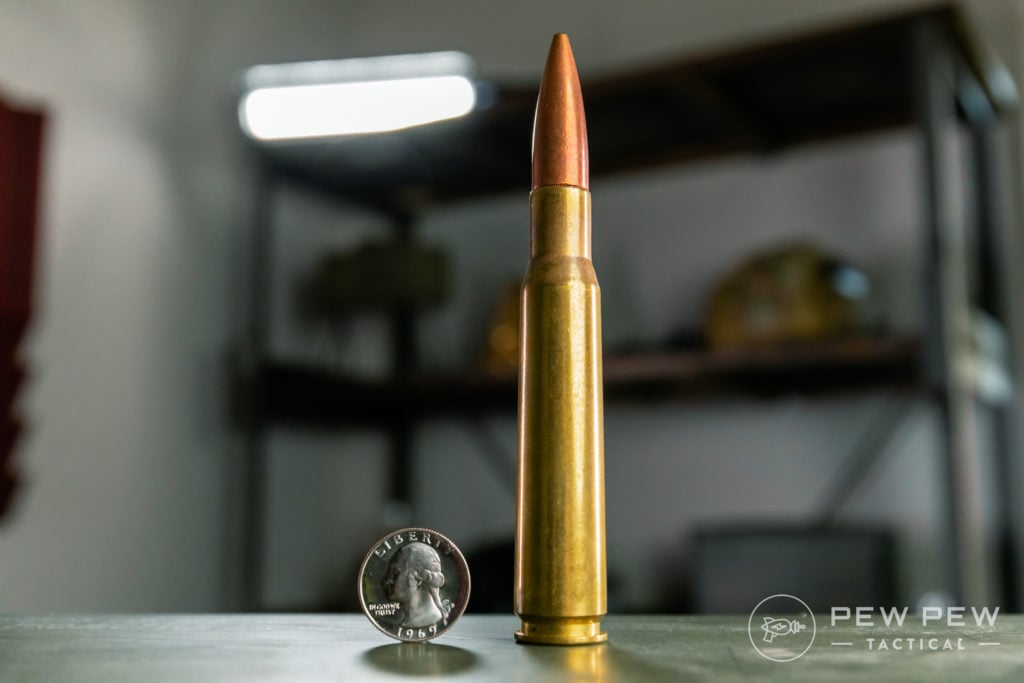
It’s huge and has huge recoil with awesome range (confirmed kills at 2,000m+), and you definitely don’t want to be on the receiving end of the bullet. 660-grains of pure stopping power.
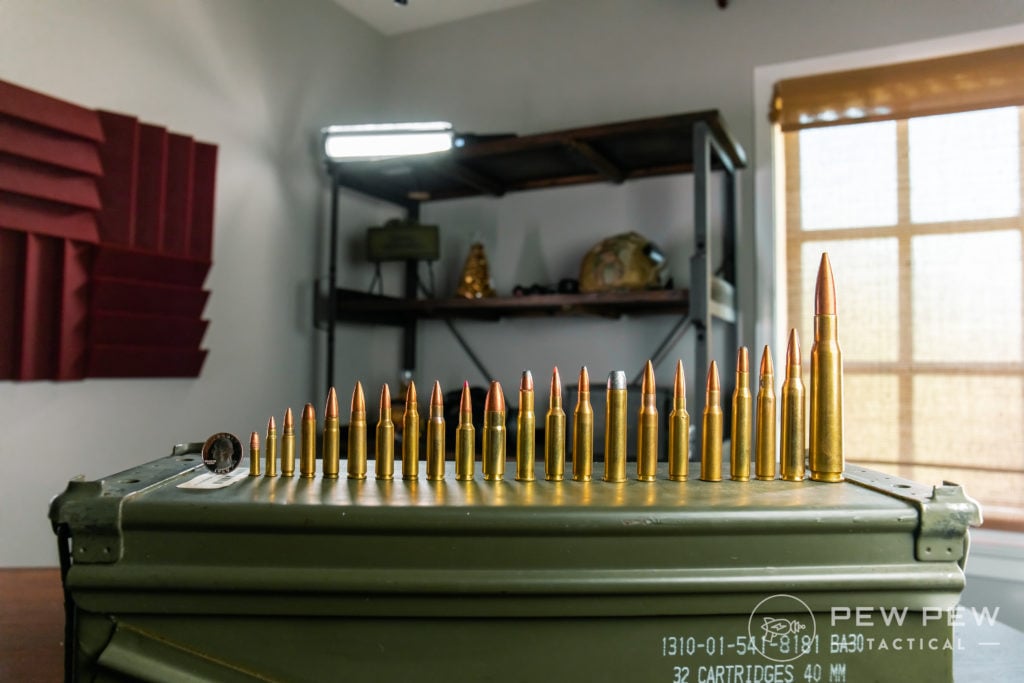
This Barrett was OK because I was standing and it had a suppressor!
Still with me?
Common Bullet Types & Terminology
Full Metal Jacket (FMJ)
This is the most common type of bullet and consists of a soft metal core, such as lead fully encapsulated by a harder metal, such as copper.
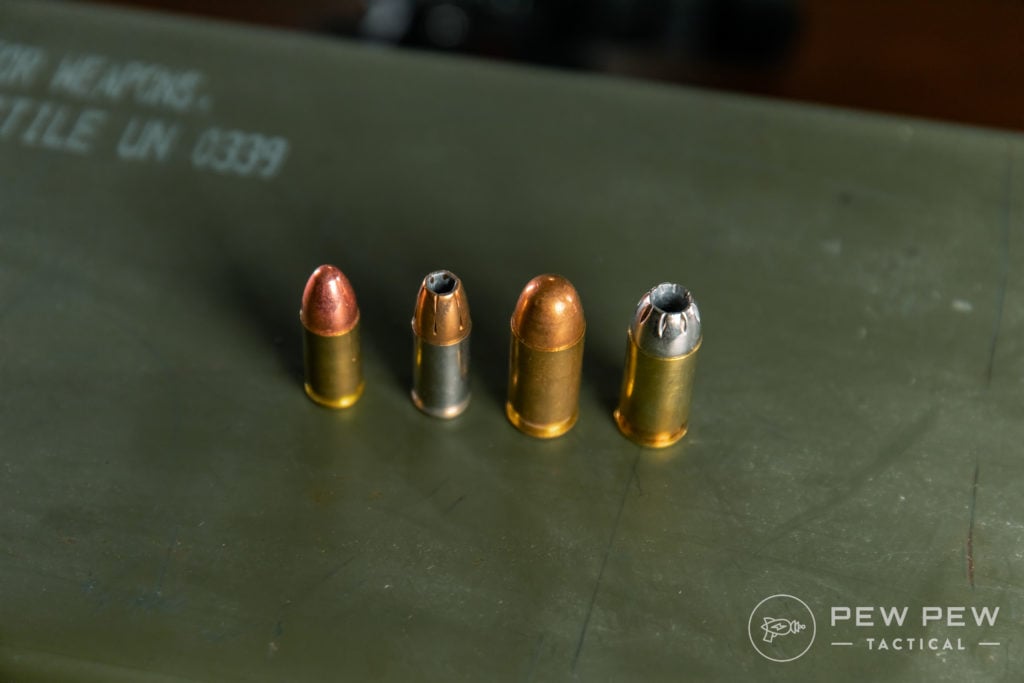
They are usually pointy, round, or even flat. Wound channels are typically small and go through a target.
Great for the range but not preferred for defensive rounds.
Hollow Point (HP)
Hollow points are made to expand once they hit something. They are the go-to round for police officers, concealed weapon carriers, and home defense guns because of their stopping power.

Open Tip (OTM)
Open-tip bullets look like hollow points since they have an opening at the top, but this is more because of their manufacturing process. The openings are too small to expand effectively.

Regular FMJ’s are created from small copper cups where the bottom of the cup becomes the tip of the bullet. Open-tip bullets are the opposite, with the bottom of the cup becoming the bottom of the bullet.
Open-tip bullets are sometimes also known as Open Tip Match (OTM) since they are preferred by long-distance shooters. The manufacturing process for open tip bullets creates a more consistent round than FMJ. Important when you’re shooting hundreds of yards!
Ballistic Tip
This is what you get when you combine the aerodynamics of an FMJ with the stopping power of a hollow point. This is a hollow point covered with (usually red) plastic to mimic the profile of an FMJ.
They are mostly used in hunting or precision shooting.
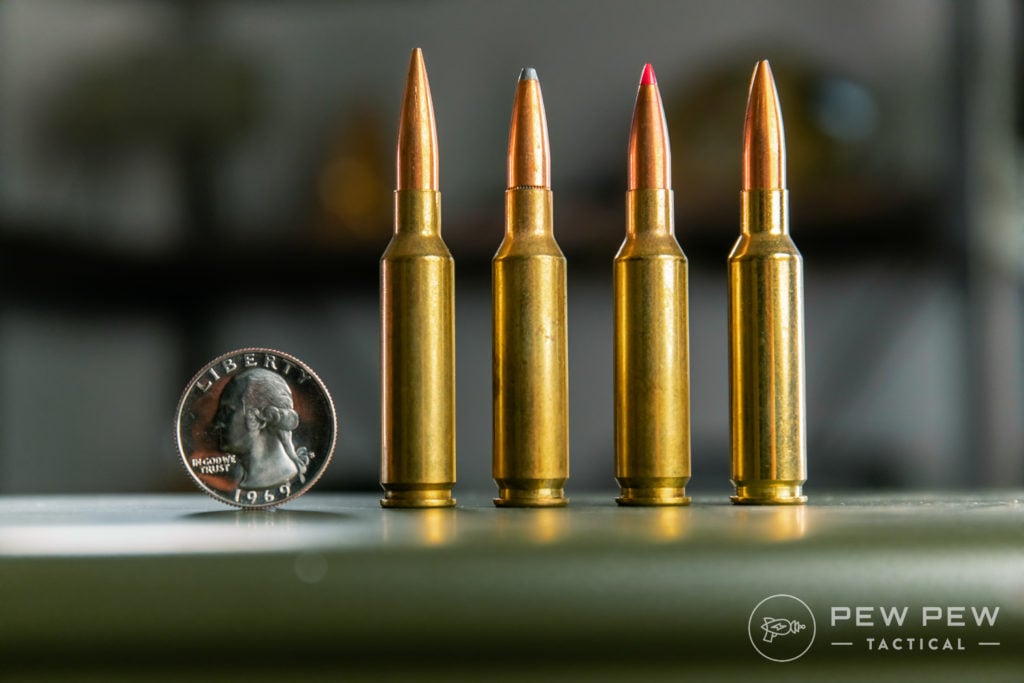
Below you’ll see that the bottoms of the bullets are more streamlined. This design is called “boat tail” and produces less drag as the bullet flies through the air. HPBT is short for “hollow point boat tail.”
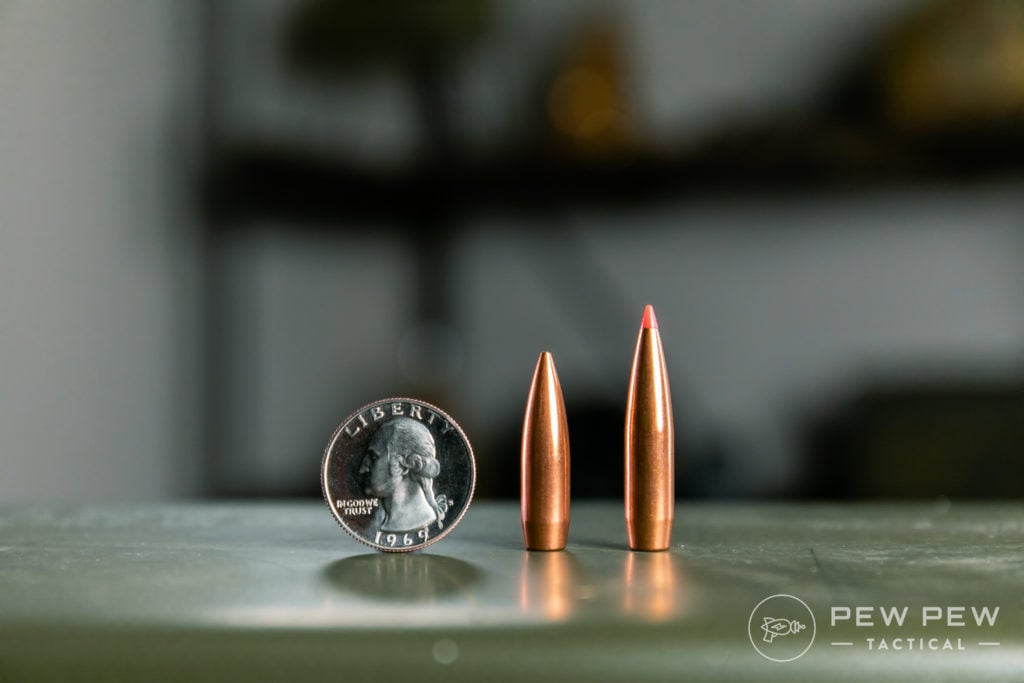
Soft Point
This is an earlier attempt to get the ballistic advantages of an FMJ with better expansion.
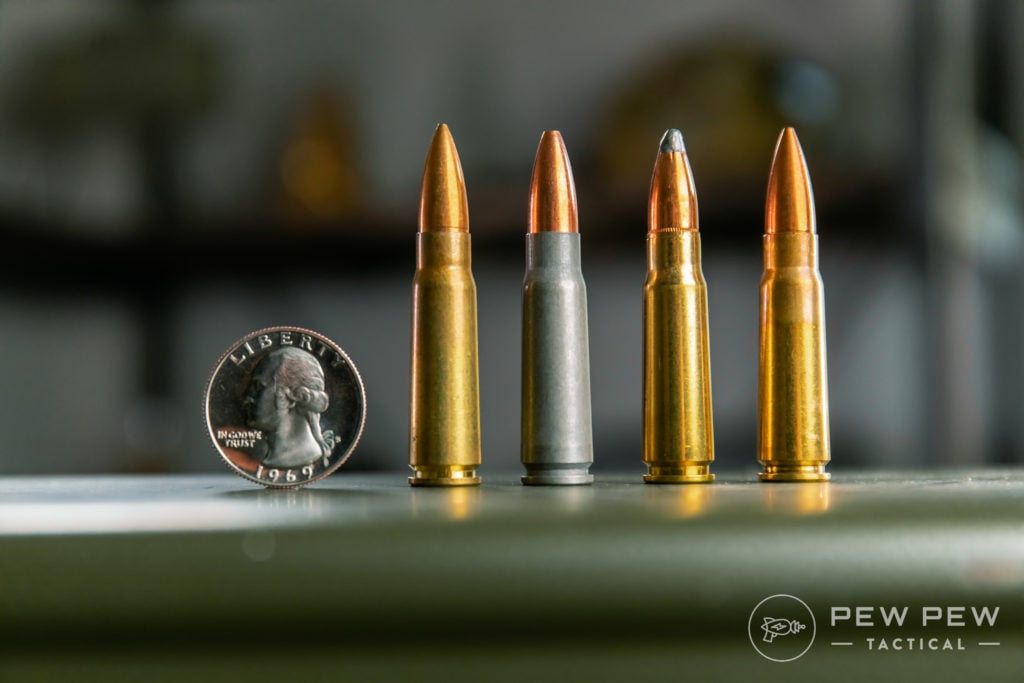
In soft point bullets, part of the lead is exposed at the tip. The softer lead is designed to flatten better when the bullet hits a target. But for the most part, ballistic tips have surpassed the performance of soft points.
Shotguns
The most popular sized shotgun round is the 12 gauge.
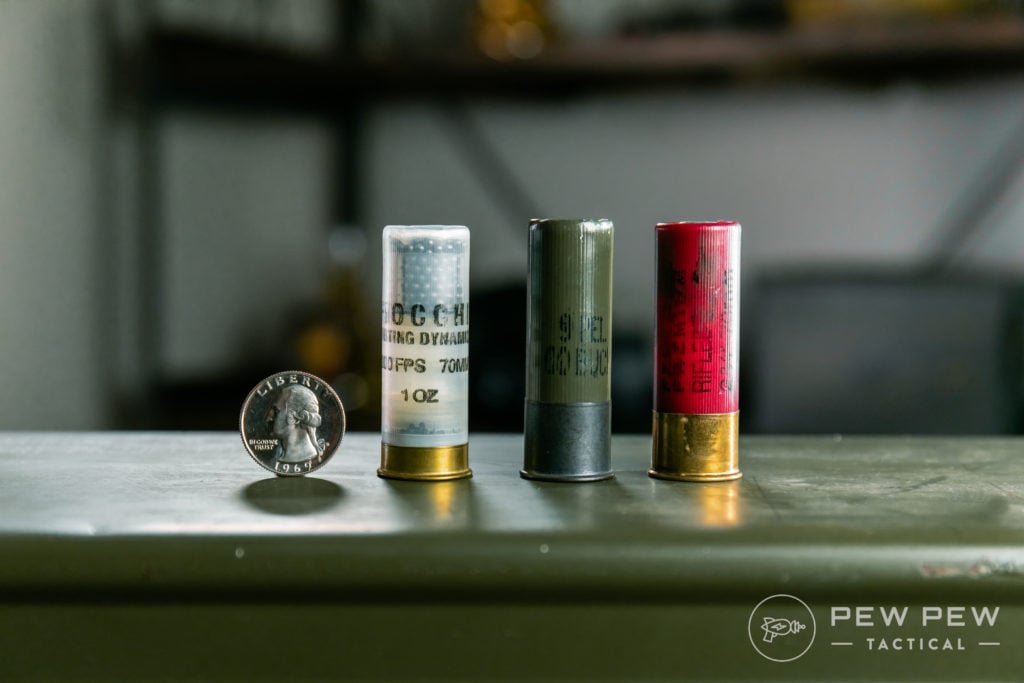
Recoil can vary from moderate to high based on round.
Shotgun ammunition is the most versatile with three main types of loads.
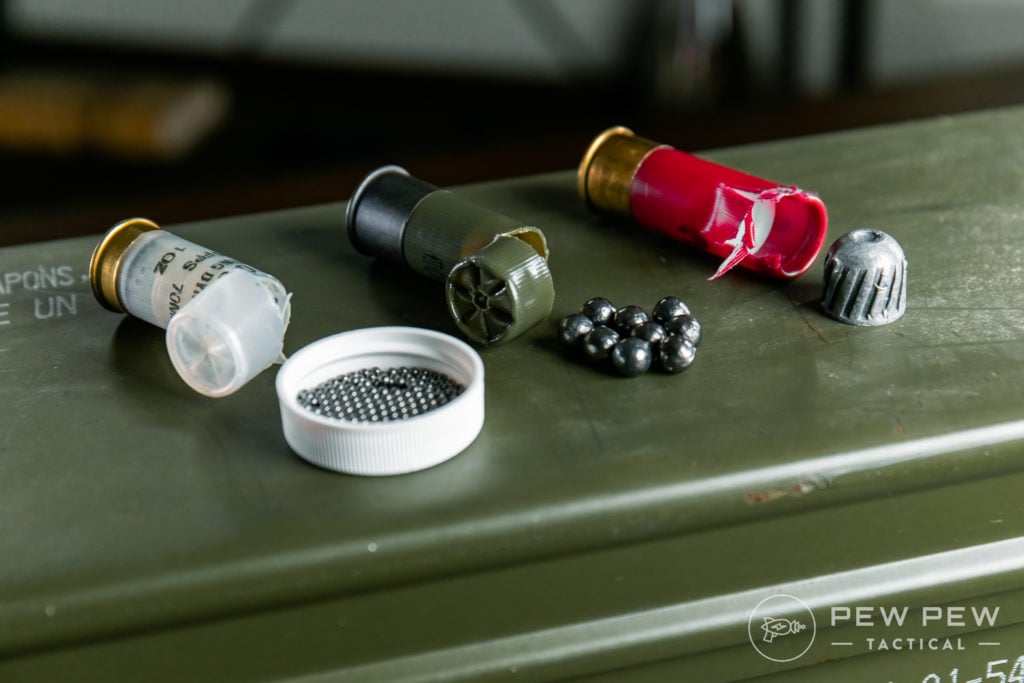
Bird Shot

Birdshot consists of the top row and is pretty small pellets numbering in the dozens in each shell.
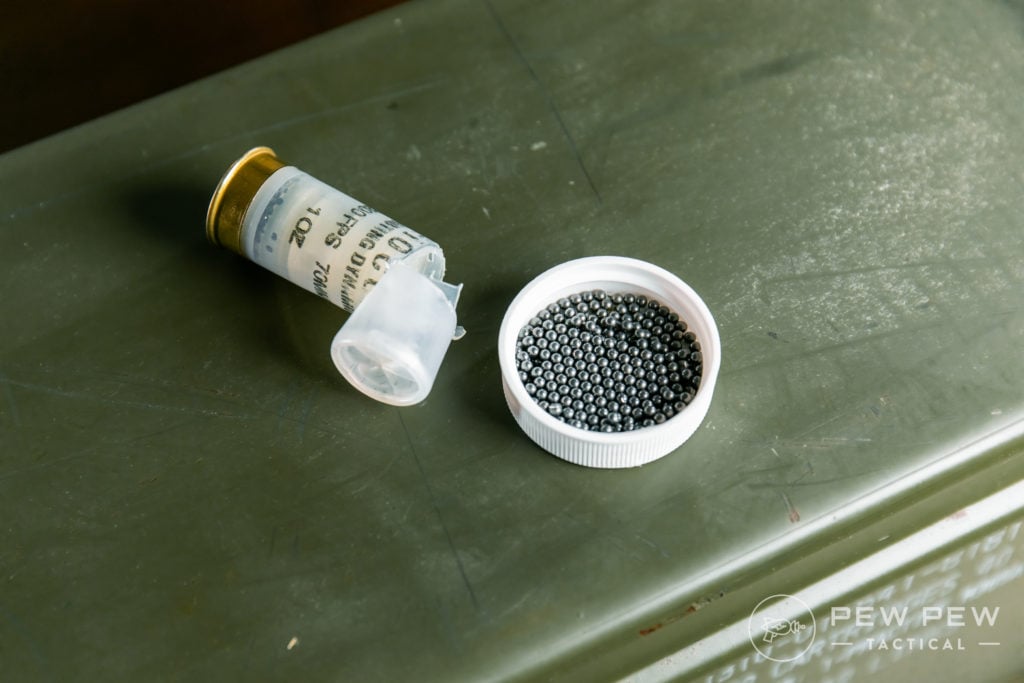
Great for hunting birds and blasting clay pigeons, but not the best for home defense.
Ok recoil.
Buck Shot
The overall best home defense round is buckshot. 00 (“double-aught”) is the go-to load.
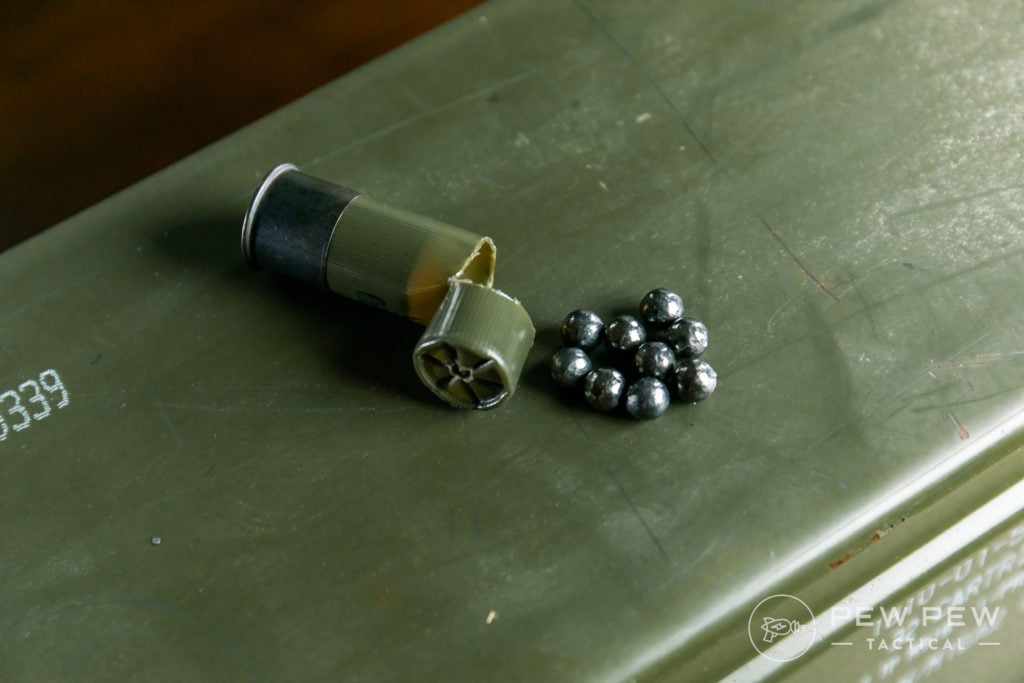
It’s nine solid lead balls the same diameter as the 9mm handgun bullet.
Much more recoil usually…but you can also find reduced-recoil buckshot rounds too.
Slugs
Slugs are single projectiles that are around 1 ounce of solid metal that really bring the hurt.
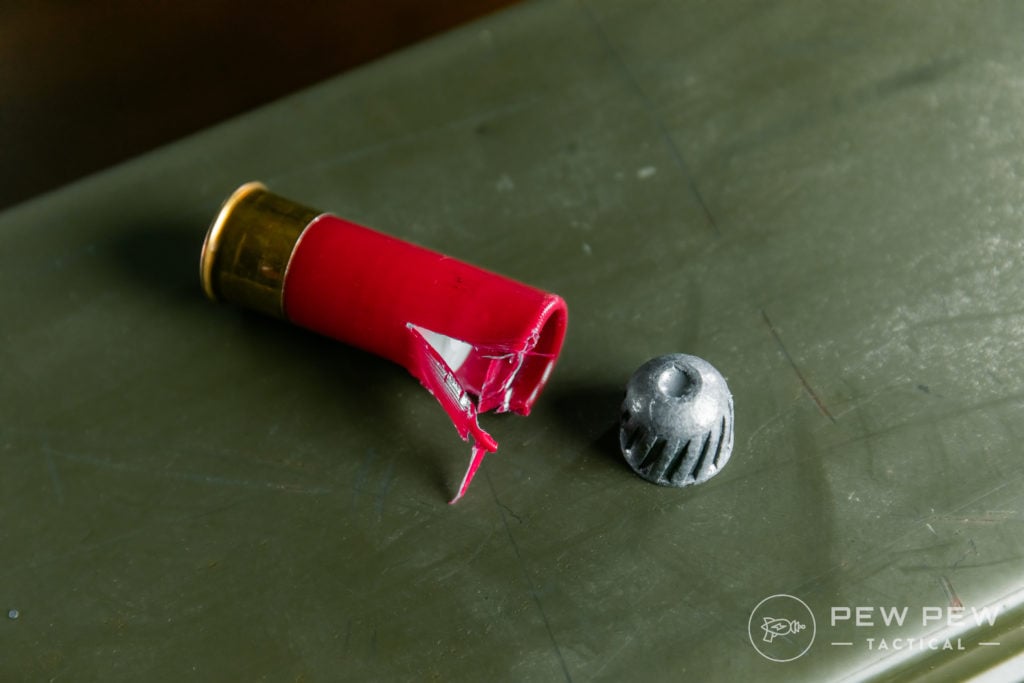
However, they don’t have the spread of birdshot or buckshot. But, in the hands of a solid shooter, they can be accurate up to 100-yards.
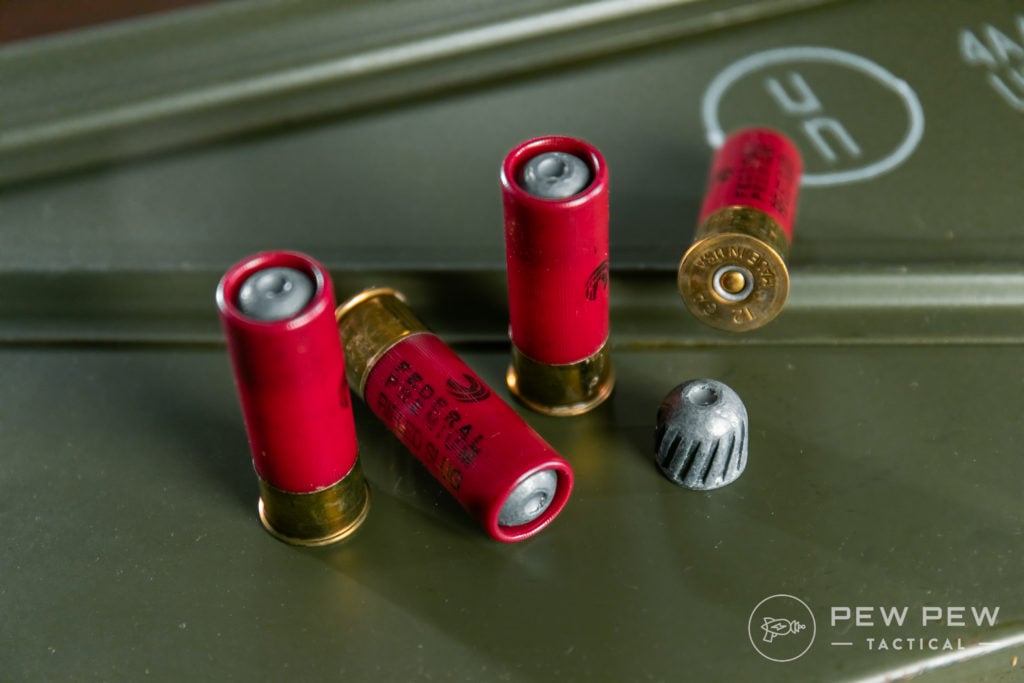
For more info:
Components of Common Cartridges
What makes up a cartridge?
Here are just a couple of breakdowns of super popular calibers. You can see the difference in powders & bullets for each type.
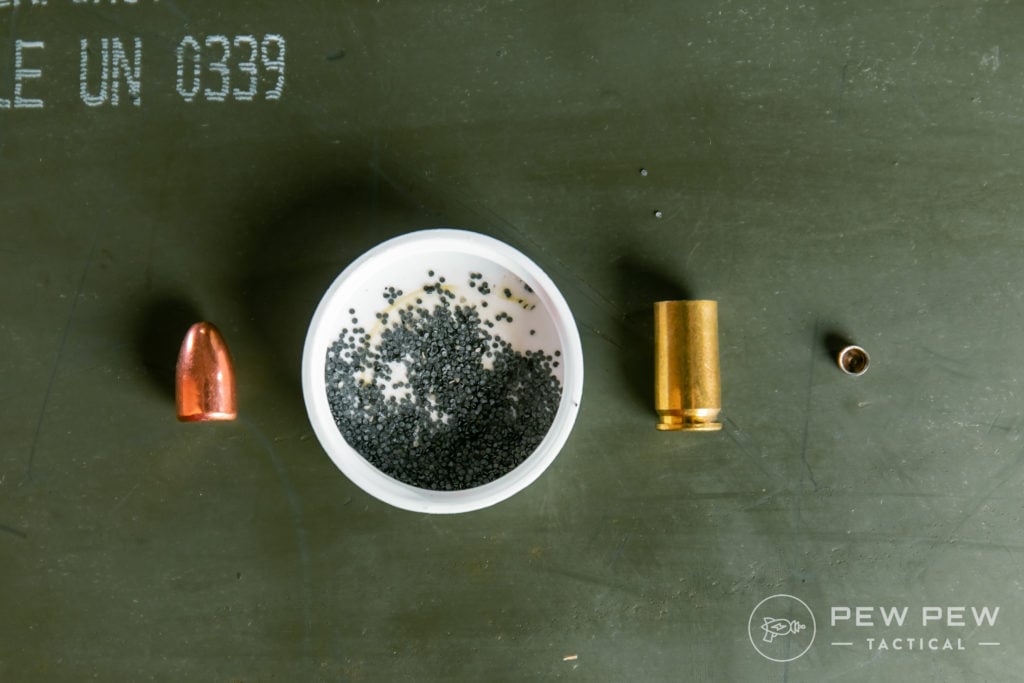

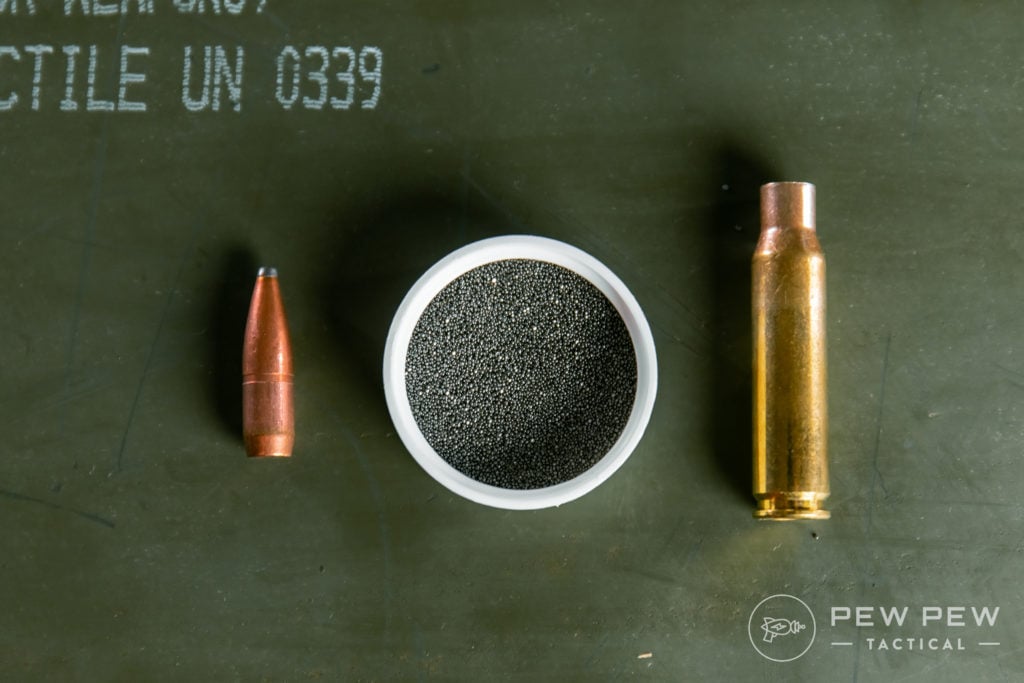
Conclusion
There you have it…now you’re a bullet pro!
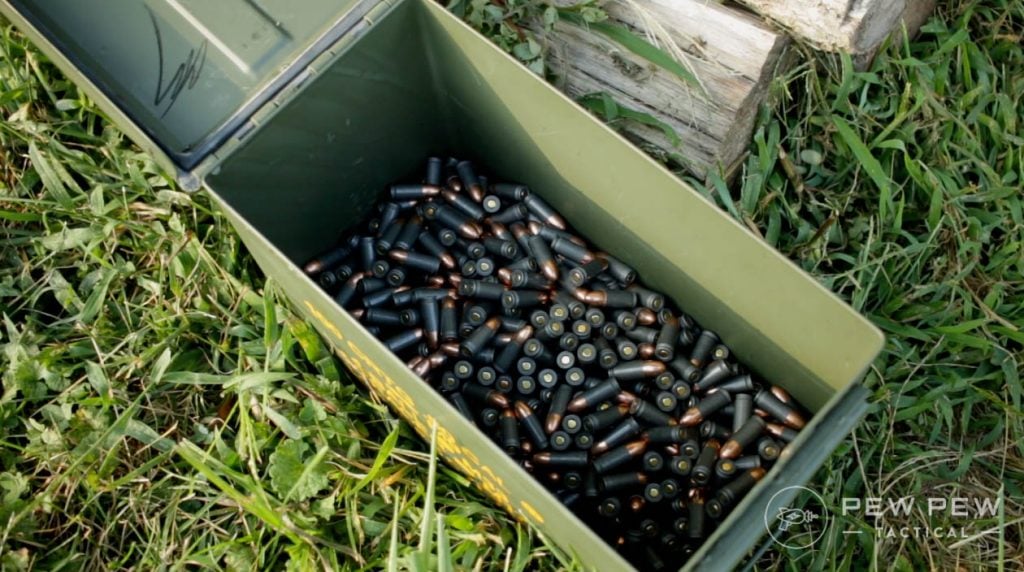
Continue on with a deeper dive into Popular Handgun Calibers, Popular Rifle Calibers, or the difference between Steel Cased and Brass Ammo…or head on over to see where to buy some Ammo Online.
And if an expertly created beginner handgun course is what you’re looking for…check out Gun Noob to Gun Slinger.

Across North America, our game species are rather diverse, and the applications for a centerfire rifle can range from prairie dogs and woodchucks to elk, moose and the great bears of the north. Add in the multitude of African species—both plains game and the true heavyweights—as well as what’s available throughout Europe and Australia, and you can imagine that the “one rifle” concept is virtually impossible. Quite obviously, the ultimate deer rifle isn’t well-suited for the serious coyote hunter, and a proper Cape buffalo/elephant stopping rifle isn’t the ideal choice for carrying up a sheep mountain. However, depending upon your level of expected hunting, you can choose three good rifles to cover the spectrum.
I’m going to remove the .22 LR from this discussion, as I feel every hunter should own one, even if just for a practice tool. So, let’s look at three choices to cover the world, with perhaps a bit of overlap. If you’re certain that the truly big-game is off the menu for you, the choices will change, and conversely, if they’re on your bucket list, you’ll need a specialized rifle to hunt them. If you’re serious about predators and varmints, a light caliber rifle with a high-magnification optic certainly makes sense, but if the odd coyote hunt in the winter or the dispatching of a rogue woodchuck is the extent of your pursuits of this class of game, your deer rifle may suffice. Let’s break it down and take a look at the possible choices.
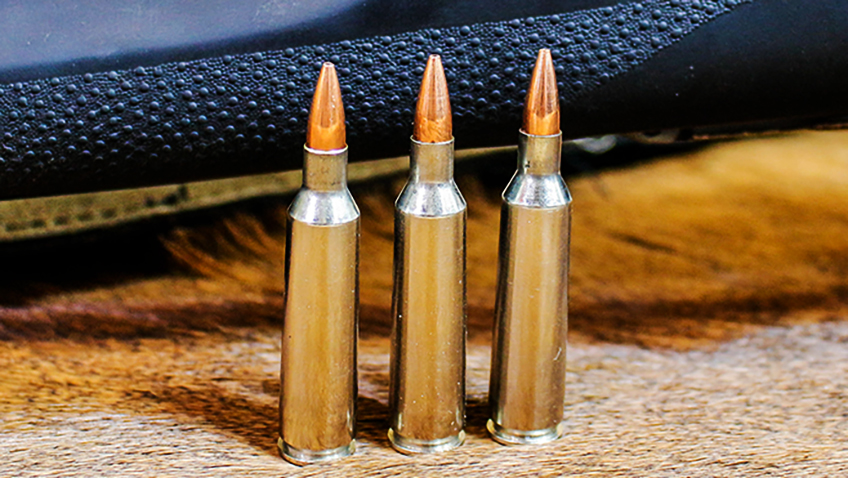
1. Varmints/Predators
This type of hunting is usually best served by a high velocity small-bore cartridge. Classic choices are the .223 Remington, .22-250 Remington and .220 Swift, though there are many more to choose from. If you enjoy the AR platform, that rifle can easily be put into use as a varmint/predator rifle, but the majority of die-hard hunters will enjoy the accuracy benefits of the bolt-action guns. Some hunters prefer the lighter calibers, like the .204 Ruger, .222 Remington or .17 Remington, while some of the serious fur hunters appreciate the heavier bullets of the 6mm cartridges, perfect for windier conditions at longer distances. Surely the new .224 Valkyrie will become a friend to the varmint hunter who hunts the open prairies of the West, or those who call coyotes across the hay lots and power lines.
Should you wish to have a rifle that will do double-duty on big game, the various .25-caliber cartridges, the 6.5mms and the .270 Winchester can be loaded with lighter bullets that will minimize the damage to the furbearers. My own personal choice is a well-worn Ruger Model 77 in .22-250 Remington, topped with a Leupold Vari-X III 6.5-20x40AO; that rifle has accounted for all sorts of woodchucks, foxes, coyotes, skunks and other small game. It’s accurate, light and suits me perfectly.
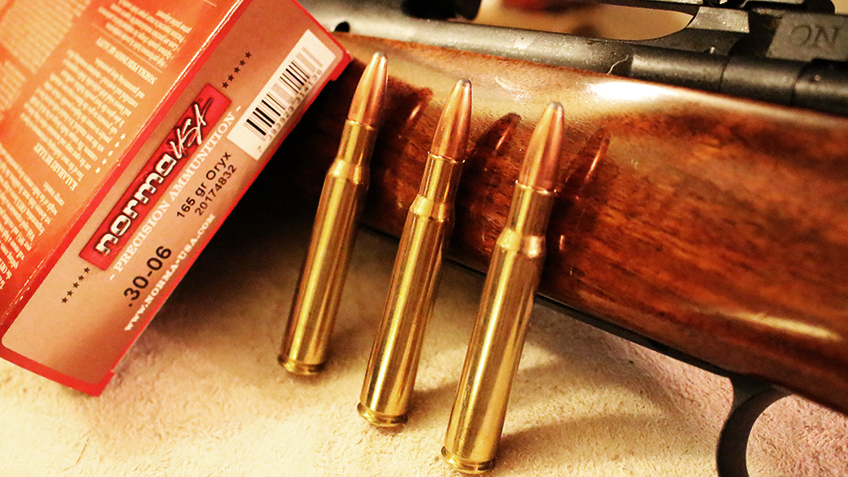
2. Deer, Sheep, Elk and Other Big Game
This will be your most-used rifle if deer hunting is your passion. There are as many good choices as there are ways to hunt deer, so take a long, hard look at what you think you’ll end up hunting. If you’re the type of hunter that enjoys the high mountain hunts in addition to the back forty, the rifle’s weight will certainly be a consideration. If you’re looking for one rig to cover many different scenarios, a trim, polymer or fiberglass stocked rifle with a weatherproof finish will certainly make a lot of sense. Not that I don’t appreciate a handsome walnut stock, but in terrible weather, the synthetic stocks certainly show their value.
Were I to pick one action style to cover these bases, it would most definitely be the bolt-action rifle, probably followed by a trim single-shot rifle, for the simplicity, durability and the cartridges they can be chambered for. There’s a good reason the 7mms and .30s are so popular: they handle a wide range of game effectively. Any of the popular designs in these calibers can make a great all-around choice, from the 7x57mm Mauser, 7mm-08 Remington and .308 Remington, through the classic .30-06 Springfield and into the 7mm Remington Magnum and .300 Winchester Magnum. The faster magnums certainly have a place, but they’re tough on meat when the shots are close, and the recoil can be a factor for some shooters. A good .270 can handle the larger species like moose and elk with good bullets, and the larger .338s can be loaded with lighter bullets for smaller game, but for my money, a good 7mm or .30 makes one of the most sensible all-around choices, and will pair well with the lighter and heavier rifles.
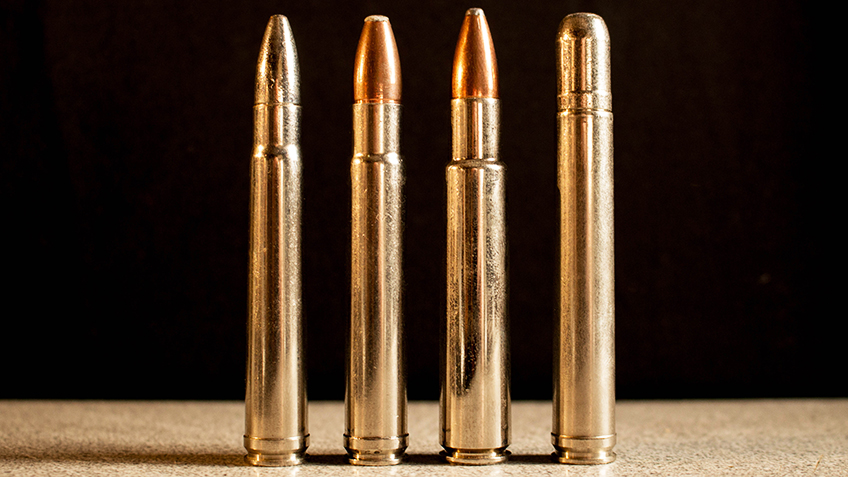
3. Large Dangerous Game
This will be the least-used category, but one that may be required to save your life. Dangerous game is, well, dangerous, and trying to get cute with too light a caliber can be catastrophic. The sensible African all-around cartridge—the .375 Holland & Holland Magnum—has been a sound choice for over a century, and will continue to be so, due to its ease on the shoulder, bullet weight and striking power. The beauty of the three-seven-five is its flexibility; with 300- and 350-grain bullets, it can handle even the largest species, yet with lighter 235- and 250-grain bullets, can be a flat-shooting affair, perfect for larger ungulates like moose and elk. Yet, there are a multitude of dangerous game cartridges that will suit the largest game animals.
The .404 Jeffery, .416 Rigby and .416 Remington Magnum, .458 Winchester Magnum and .458 Lott; all make sound choices for the bolt guns, while the .45-70 Government and .450 Marlin can be effective lever gun choices, especially for Alaska. Among the double rifles, you find the .450/400 3″ NE, .450 NE and .470 NE are all popular choices if you’re inclined to own a double. The larger calibers certainly offer lots of stopping power, but give up a bit in trajectory. Among the most versatile are the .375 H&H, .404 Jeffery, and the .416s; in my opinion they have a bullet weight range and velocity that gives a bit more range.
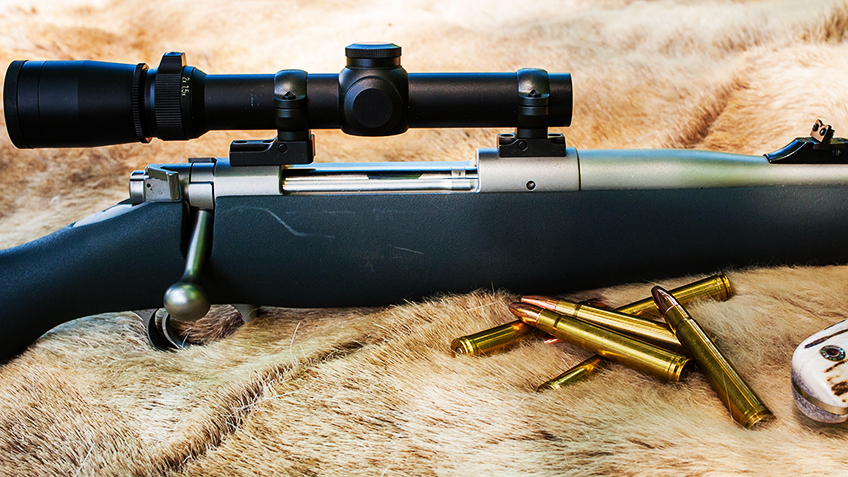
Three-Gun Batteries
For years, my own three-gun battery consisted of that .22-250, a Ruger 77 in .308 and a Winchester 70 in .375 H&H. Of course, I picked up other rifles along the way, and to my mind, the .300 Winchester Magnum made a sensible replacement to the .308 as an all-around choice, and then I discovered the virtues of the .416 Remington Magnum, especially for large game like Cape buffalo. Then a .404 Jeffery entered my world, along with a .470 NE double rifle, and then a sweet .275 Rigby; while I am intrigued by cartridge performance, a combination of any of these classics would suffice, including my original .22-250/.308/.375 combo.
If you plan on staying on North American soil, the .35 Whelen, 9.3x62mm Mauser or .338 Winchester Magnum could easily be substituted for the heavier cartridges, and would still pair well with a 7mm or .30, or perhaps the middle rifle could drop down to a 6.5mm. Like I said, there’s a ton of overlap in our cartridge choices, but with a little bit of planning, you can cover an awful lot of ground with a trio of rifles.
